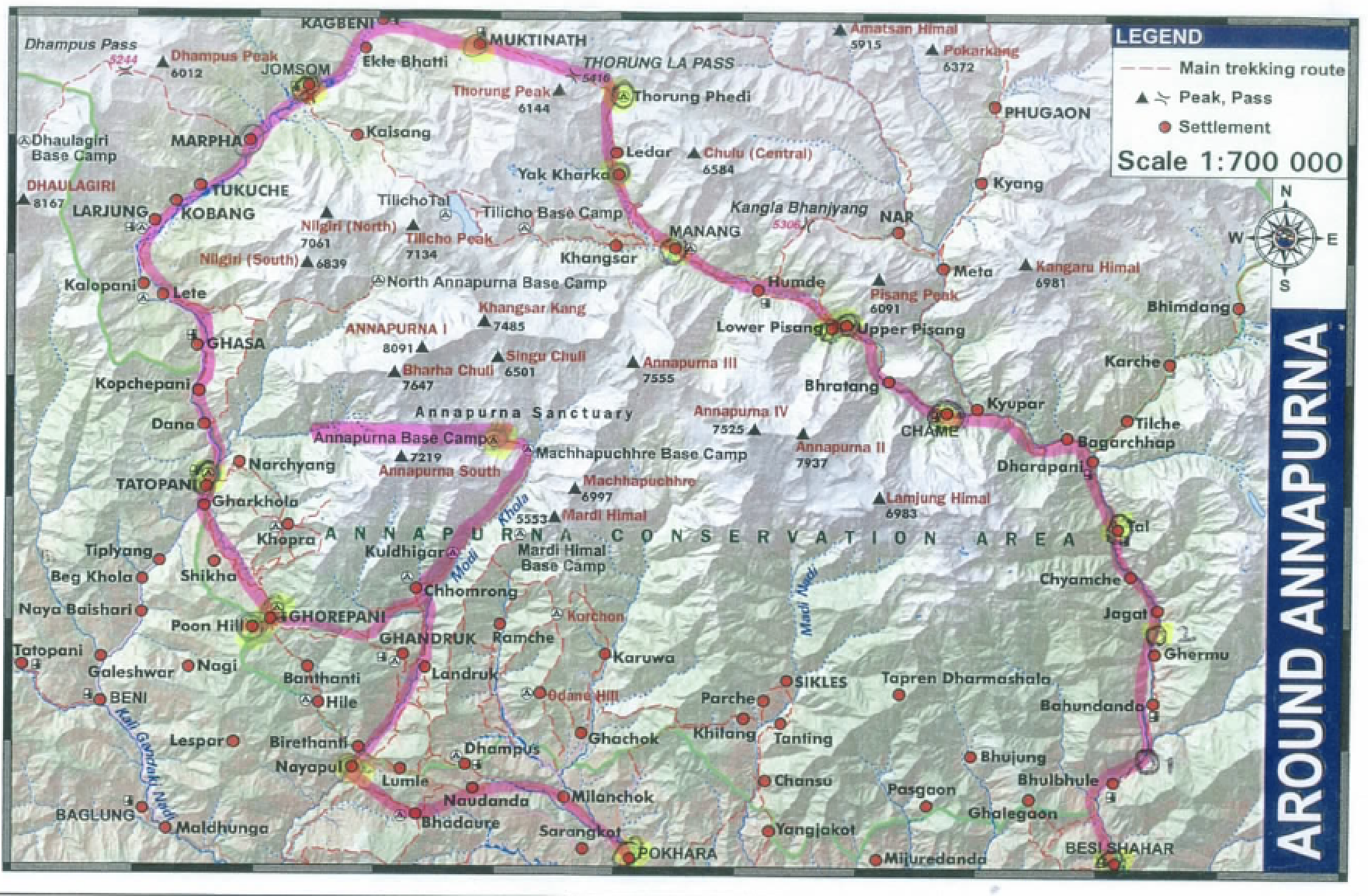
Arrival
Nepal is in South Asia, wedged between China and India and is located in the Himalayas. It is home to eight out of the ten highest mountains in the world including Mount Everest. Just to be clear, we did not climb Mount Everest. Our climbing resume calls for a few more trips back to Nepal before this and Graham also promised me a few kids before exposing his brain to the death zone. I’ll leave that story for another day….
Late October 2016 our bags were packed with an assortment of Columbia, North Face and Patagonia gear as well as socks which cost no less than 20 dollars a pair. Excitedly we travelled for two days to breath the Everest air, the same air that has alluded so many trekkers and mountaineers before us.
The usual dragging commute was not too bad. Thanks to some lovely credit card benefits we had access to all the prime airport lounges and for some reason, Turkish airlines decided to upgrade us to business class for over booking the plane. As we flew into Kathmandu the mountains were level with our plane imposingly shining back at us as the sun rose behind them. The eight-thousanders were easy to pick from the peaks. They were so majestic, intimidating but at the same time awe inspiring, leaving us with our heads stuck to the frosted oval plane window.
Like most third world countries, the airports and traffic, work in organized chaos. Our visa took short of two hours as our beloved fellow travellers were notorious line cutters. Similarly, each taxi smells heavily like body odour, increasing with each arm movement as the driver downshifts. Kathmandu is one of the most colourful cities I have seen. The concrete jungle consisted of colourful houses in bright greens, blues and reds, while the streets had colourful sand and flower petals decorating the sidewalk as offerings to worship their Hindu gods and goddesses. The streets themselves were canopied with tinsel streamers, lights and prayer flags to celebrate the Tihar festival, which is a five-day festival in November showing reverence to not only humans and gods but also animals. By the fourth day, we along with the stray dogs and cows, proceeded to walk around with red dots on our foreheads. It was a peaceful and beautiful feeling to be welcomed into the culture and religion of this country.
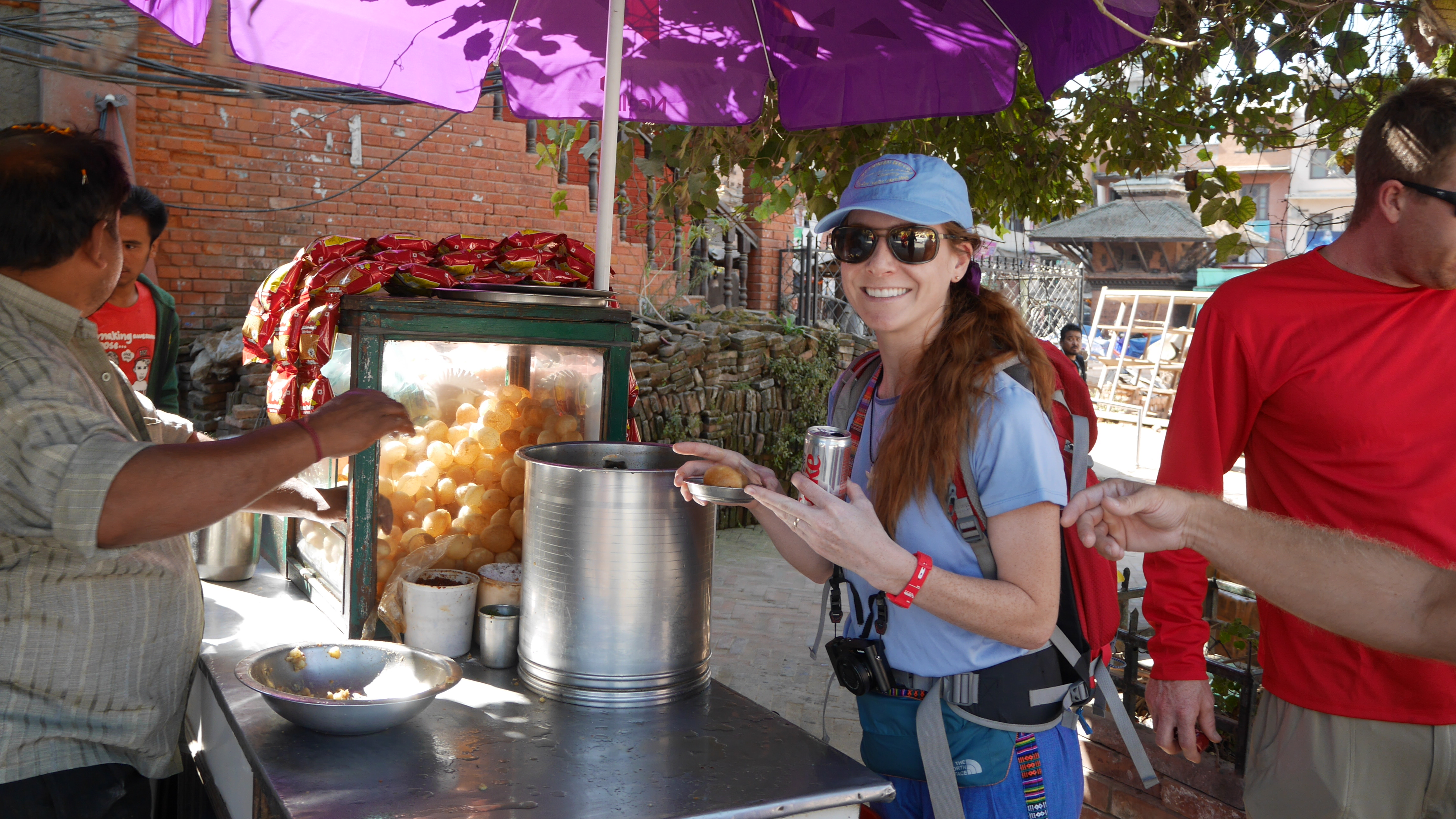
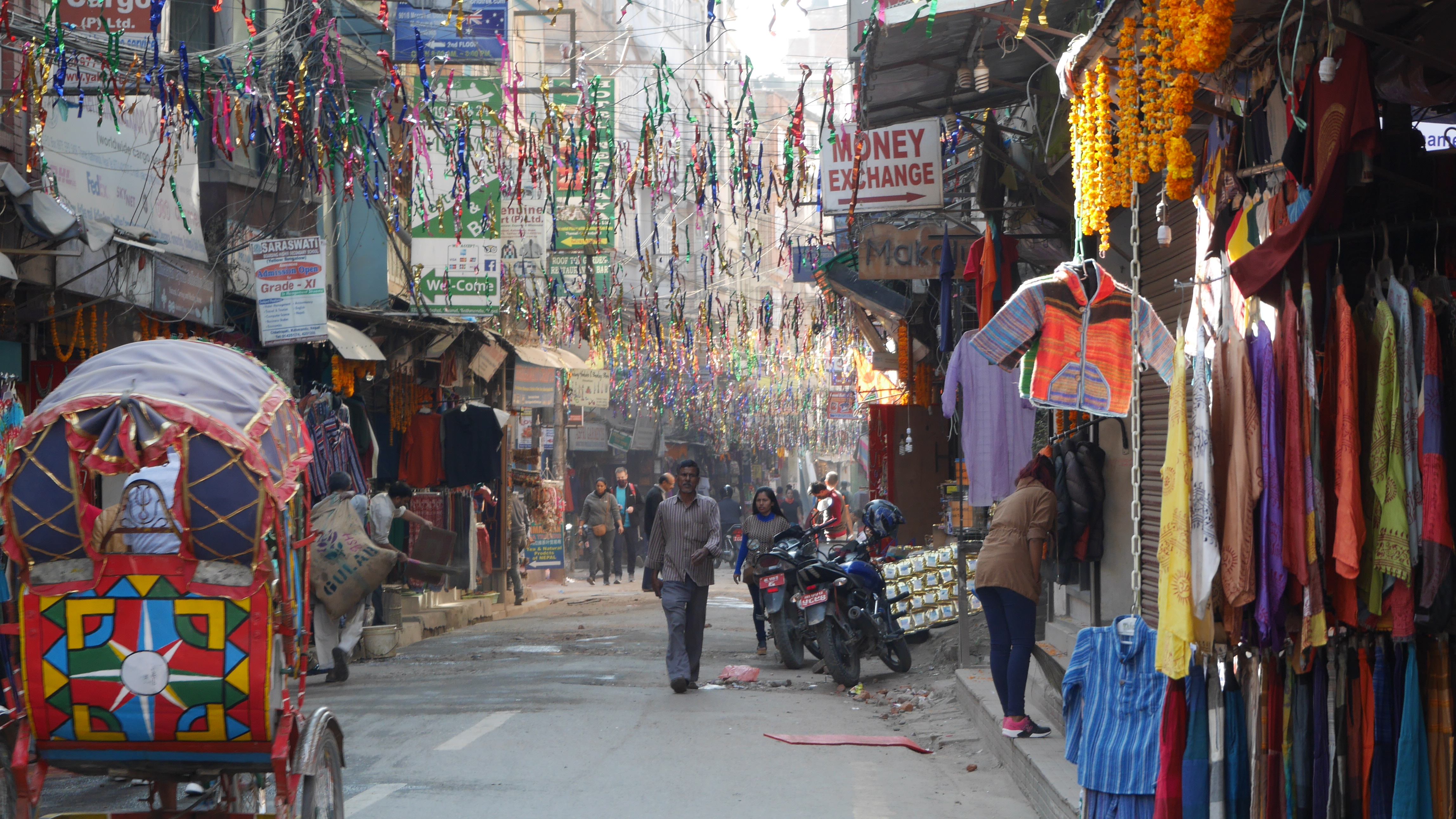
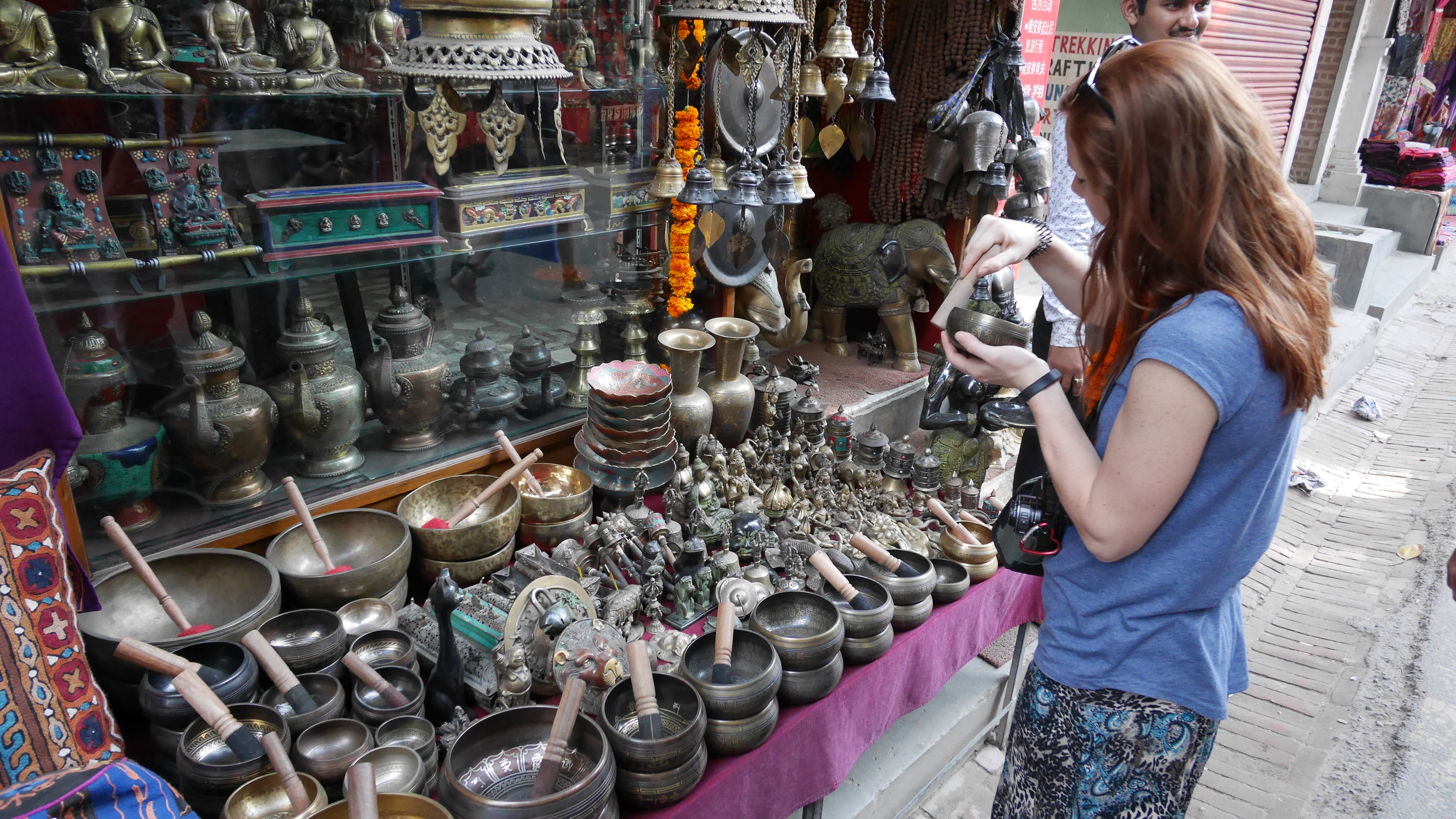
Whitewater Rafting
Graham and I arrived three days before the rest of the family, giving us a chance to explore what else Kathmandu had to offer before heading for the mountains. We quickly learned that Nepal was also the ultimate white-water playground. We of course wanted the ultimate adrenaline rush so we chose no other river but the mystifying power of the Bhote Koshe. The river draws power up from the 10th highest mountain and rumbles into Nepal through glaciers and breath taking valleys. Rapids are a solid class V and VI and have the steepest descent of all rivers in Nepal. Why would we pick any other? We took a two day/one night rafting camp where we sent our adrenaline through the roof and awakened muscles I forgot I had. On the first day we chose not to wear wetsuits, the locals assured us that it was not so cold, but off course us Galvestonians were in for multiple cringes as the water bucketed us as we plunged on down. On the first day we had five minutes of instruction and then we set off for multiple three-four hour sessions. On the last day I also tried some white water kayaking. While browsing the internet this was labelled as a must do, yet my appeal was never tempted, thinking it was just traditional kayaking like at home. How wrong I was! These single seater kayaks were literally extensions of your legs, attached by a water proof seal and you used your hips to salsa down the rapids. Any loss of attention would have the white-water throw you off balance making you proceed in the ice cold water upside down struggling to breath. I took a brief trial in some rumbling and flat water, leaving anything rapid for another day. One look at the poor guy learning before me doggy paddle for his life was enough.
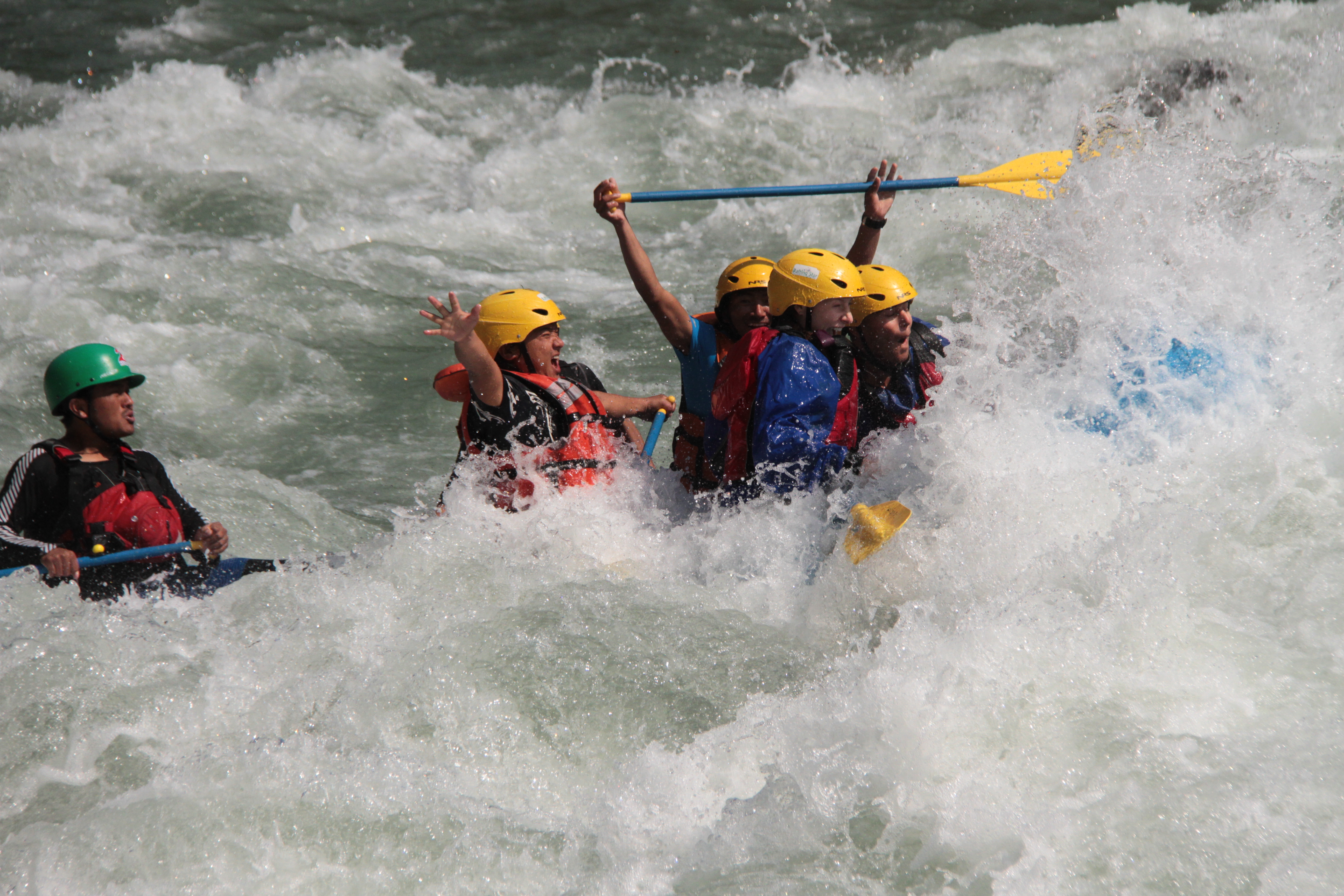
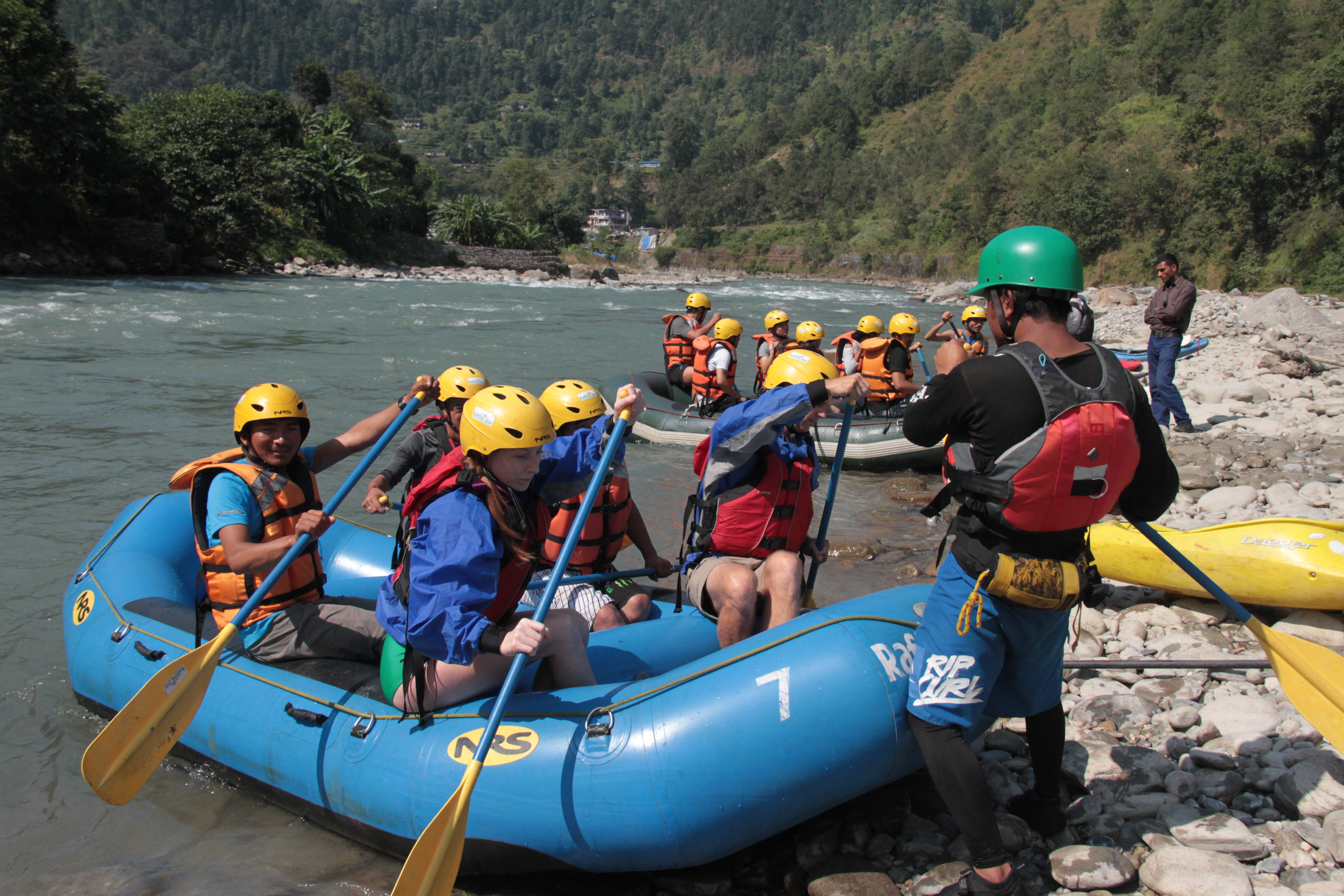
To break up our time on the rapids we went on a “Nepali” hike, which consisted of a very steep hike starting at four o’clock in the afternoon for eight miles. Of course we had no idea, so we ended up scrambling to get back in the dark. What was special about the hike was that we went so high up into the mountains where the Nepalese people had not seen tourists or white people, making them very curious and invited us into their mud and tin roof homes with big smiles. Curiously we accepted communicating through our guide as one of the ladies brought out peculiar fruits for us to try. So for our rest stop we joined her for pomelo’s resembling a grapefruit on steroids, while we gave her children some nice processed cookies from our own stash of snacks. As we left the children walked with us yelling ‘hello’ as we left their village, (I’m guessing that was the extent of their English). It was nice to see that the children here still smiled for free, unlike in other countries where they often came with begging palms.
Company: www.raftingstar.com

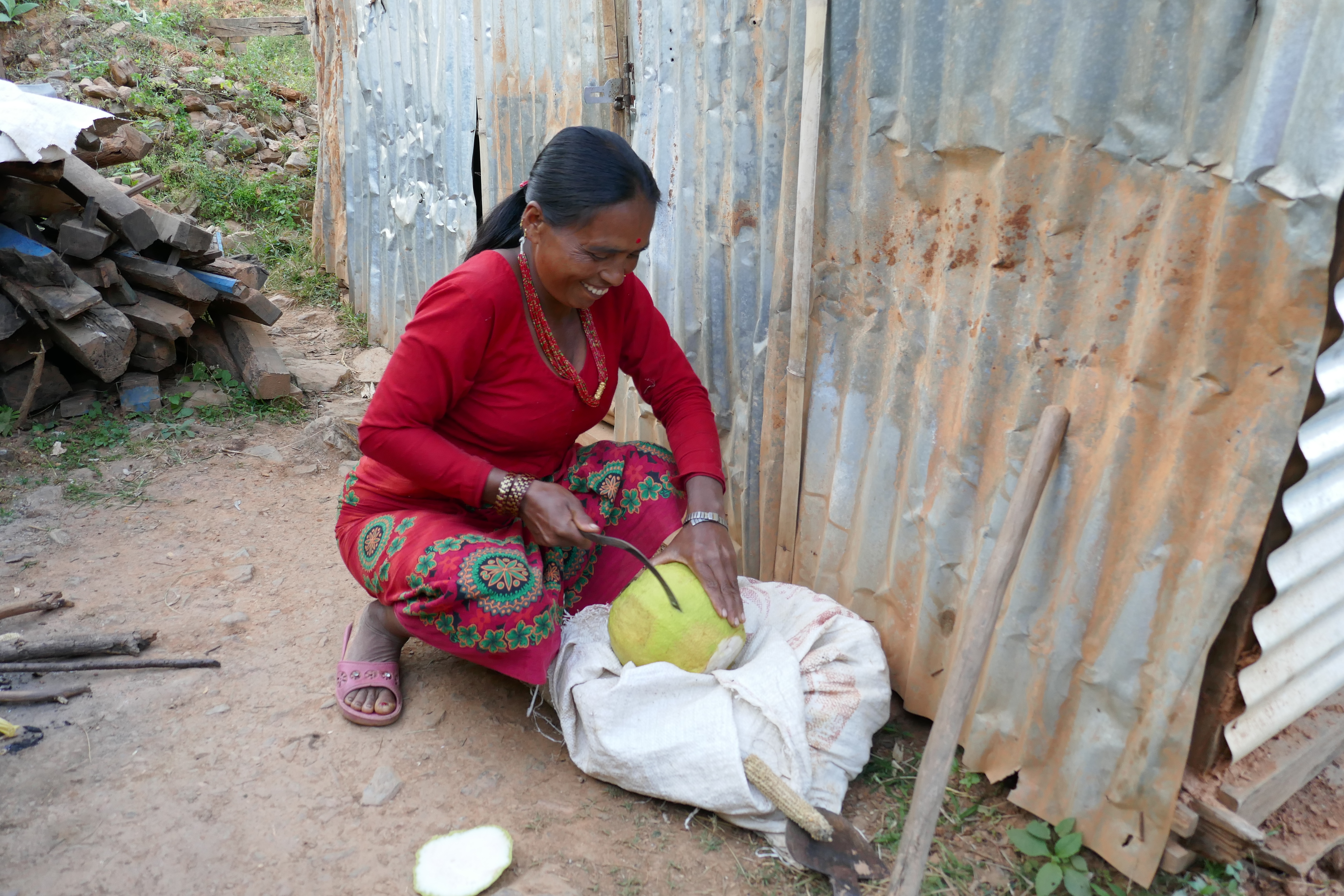
Mountain Biking
We got a real taste of just how dusty Nepal was on our mountain biking trip the following day where a buff was essential. The leaves on the side of the road no longer resembled a shade of green and the most religious nose picker would easily kick his habit. Mountain biking in Nepal was very different to our GHORBA trials. Never again will I complain that our trials are rooty, because rocky is much worse. We went for roughly 38 km, riding from Kathmandu up the surrounding mountain rim circling part of the city. The ride was challenging to say the least, consisting of uphill on rocky terrain, high elevation and 90 degree heat. Our guide also had no concept of taking a rest or pictures. The challenge I could handle, however it all fell apart for me returning to the busy streets of Kathmandu. While most of the ride had no sharp turns, we were instead dodging scooters and cars for the safety of our lives. By the end I was at least 100m behind the guide and Graham, having been cut off by a scooter at an intersection earlier and I just panicked and started to hyperventilate. In Nepal there is no such thing as an indicator or traffic lights, the horn works in place of both. My buff no longer worked to shield for dust, it was hiding my lip curling unflattering howl as I dodged the traffic. I was expecting to be collided with at any time, knowing very well the only thing the Nepalese people stop for was a holy cow.
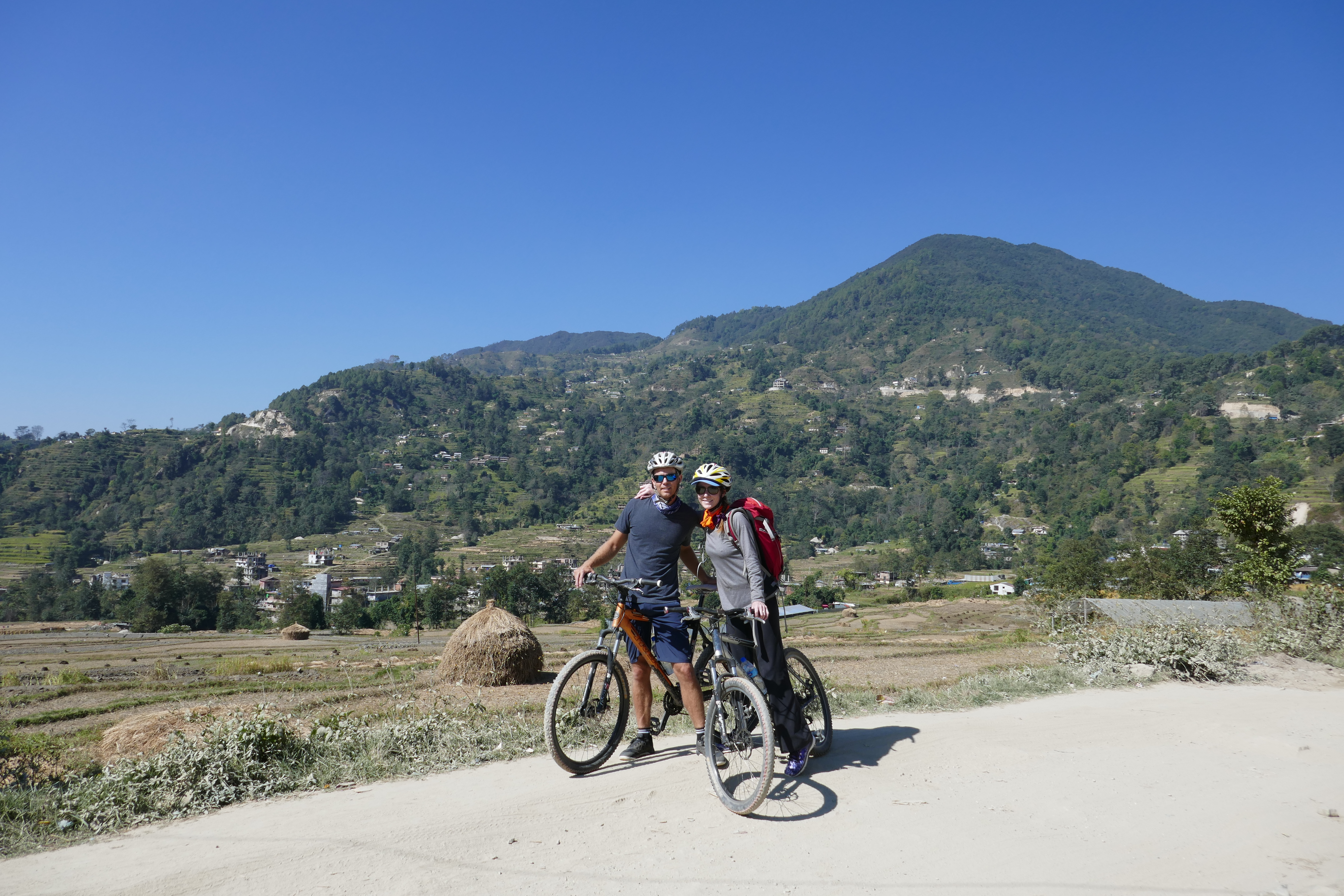
Kathmandu City Tour
By day three my family finally arrived including my mum (Karin), dad (Bruno), brother (Sebastian), sister (Ela) and my brother’s girlfriend (Philippa). Our joy, anticipation and excitement was immense as was our huge pile of bags filling up the hotel lobby. We spent the first two days together exploring Kathmandu city, a city of monuments, temples and monasteries. The wood work in many of the temples and monastics was more detailed and spectacular than anything I have ever seen. All I can say is look at the detail in the pictures and interpret the stories that the carvings tell. Devastatingly, many of the sites were destroyed or severely damaged by the earth quake in April 2015. Even 1.5 years post, the reconstruction was slow and time consuming to bring it back exactly as it was. It was however easy to appreciate the beauty that once was. The colourful offerings and sweet smell of incense in the air made the atmosphere peaceful and calming. Of the 30 million people that live in Nepal, they appear to live in religious harmony. Hinduism and Buddhism were side by side, both bringing out our own spirituality.
The places we visited included:
Durbar square
Pashupatinath
Bouddhanath
Swoyambhunath
Change Narayan
Budhhanilkantha
Narayanhiti palace
Bhaktapur. In a palace in the centre of the city of Bhaktapur we shared a minute with a living Goddess. Not many can say they have been blessed by a real living goddess! (sorry no photography allowed)

Pashupatinath temple was the most outstanding. In Nepal this temple is the most famous, sacred Hindu temple dedicated to human cremation on the Ghats of the Bagmati River. As we approached we already saw the smoke from burning bodies. In Nepal, all Hindu bodies are burned here after a cleansing ceremony at the temple. The family then builds a fire on designated platforms along the river, on top of which the body is set on fire. After three hours of watching the body burn, the ashes are scattered in the river. The river is considered holy. What was even more amazing is that the entire ceremony is entirely public with no option of privacy.
It was a jam packed few days of site-seeing. It was truthfully very difficult for me as I had picked up a severe case of traveller’s diarrhea. It was a complete intestine cleanse with no clean or conveniently located toilets. Luckily I was able to pick up antibiotics, electrolytes and anti-diarrhea tablets from the street pharmacy for a grand total of $1.50, leaving me shortly cured.
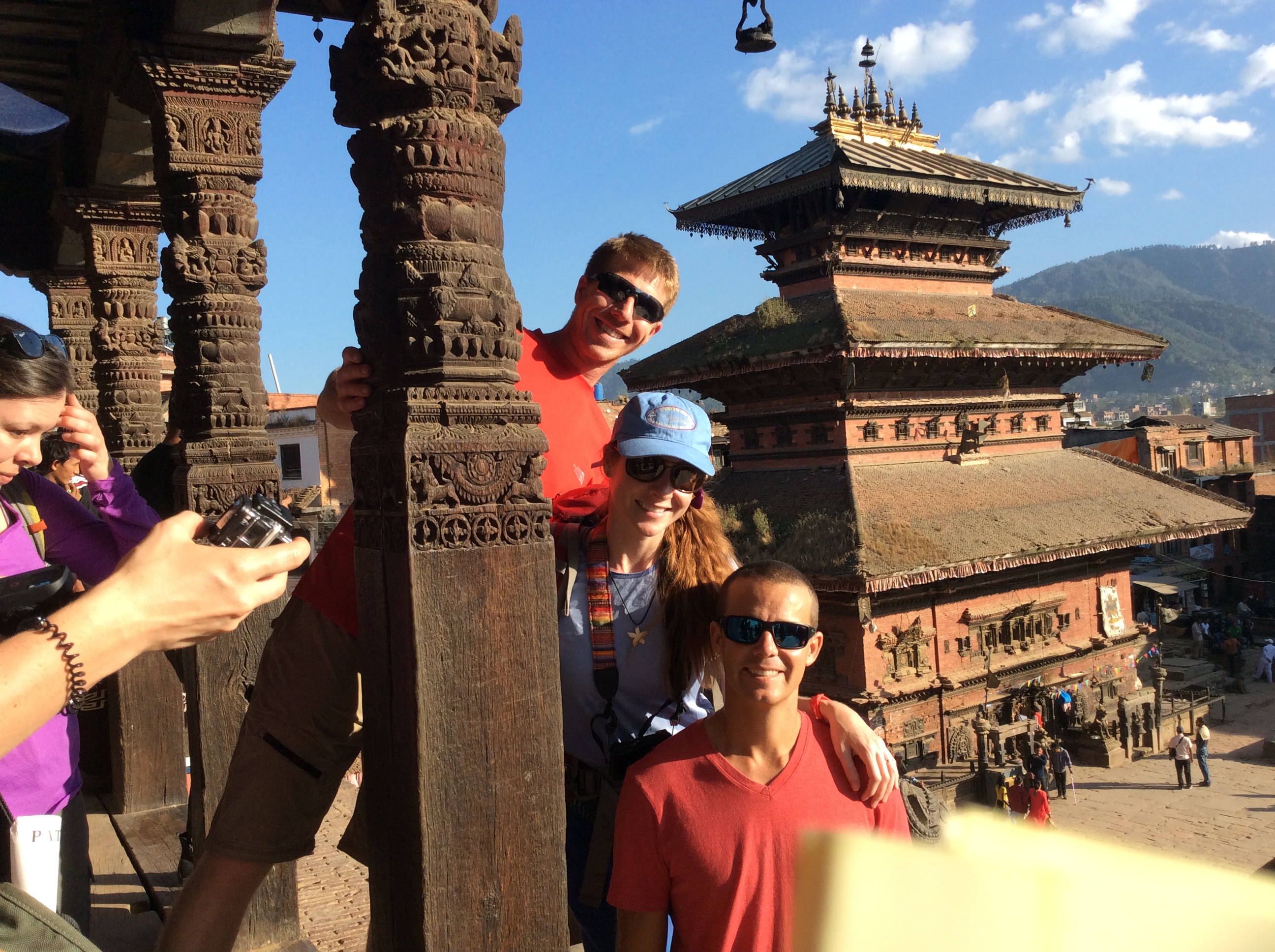
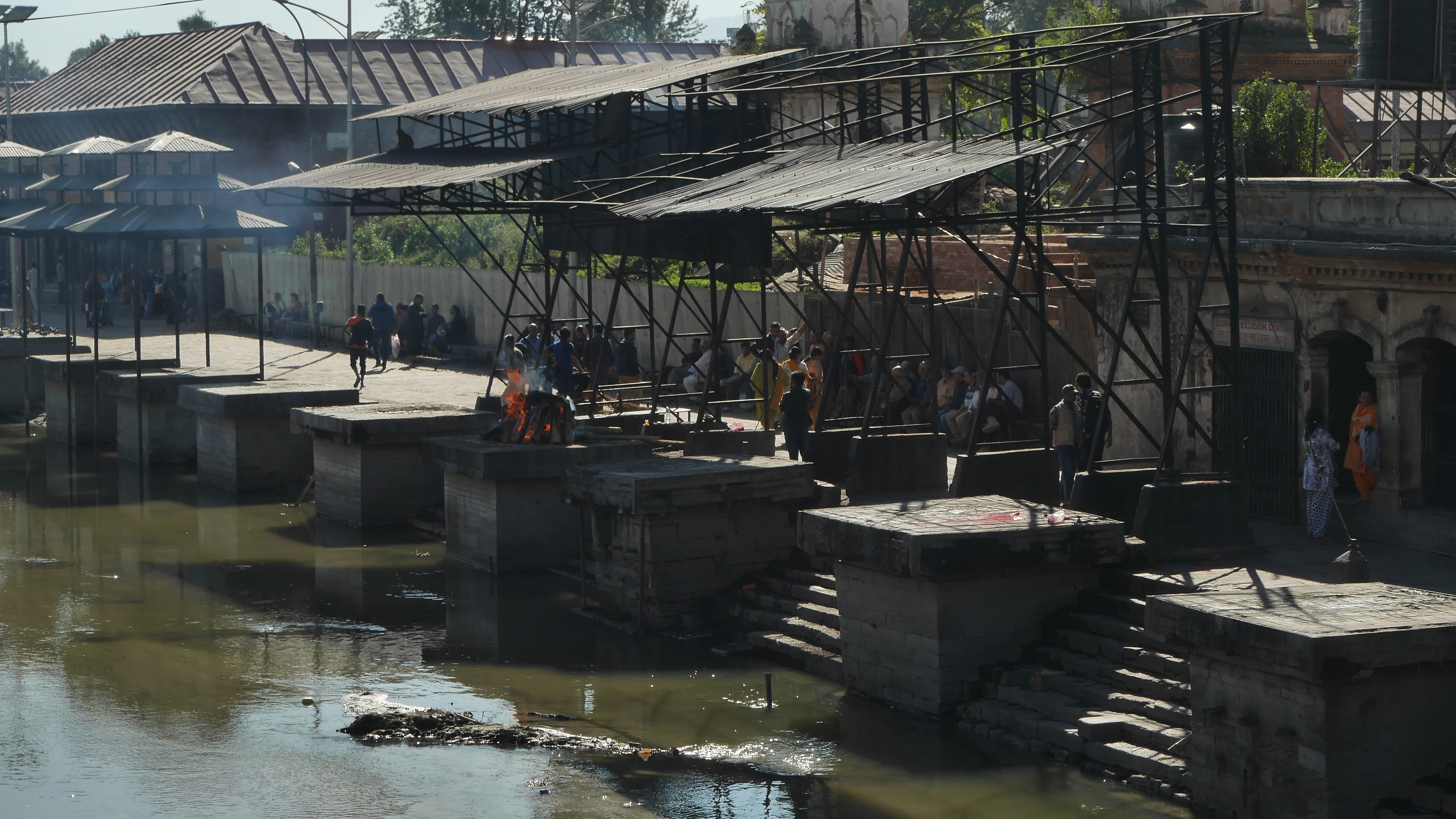
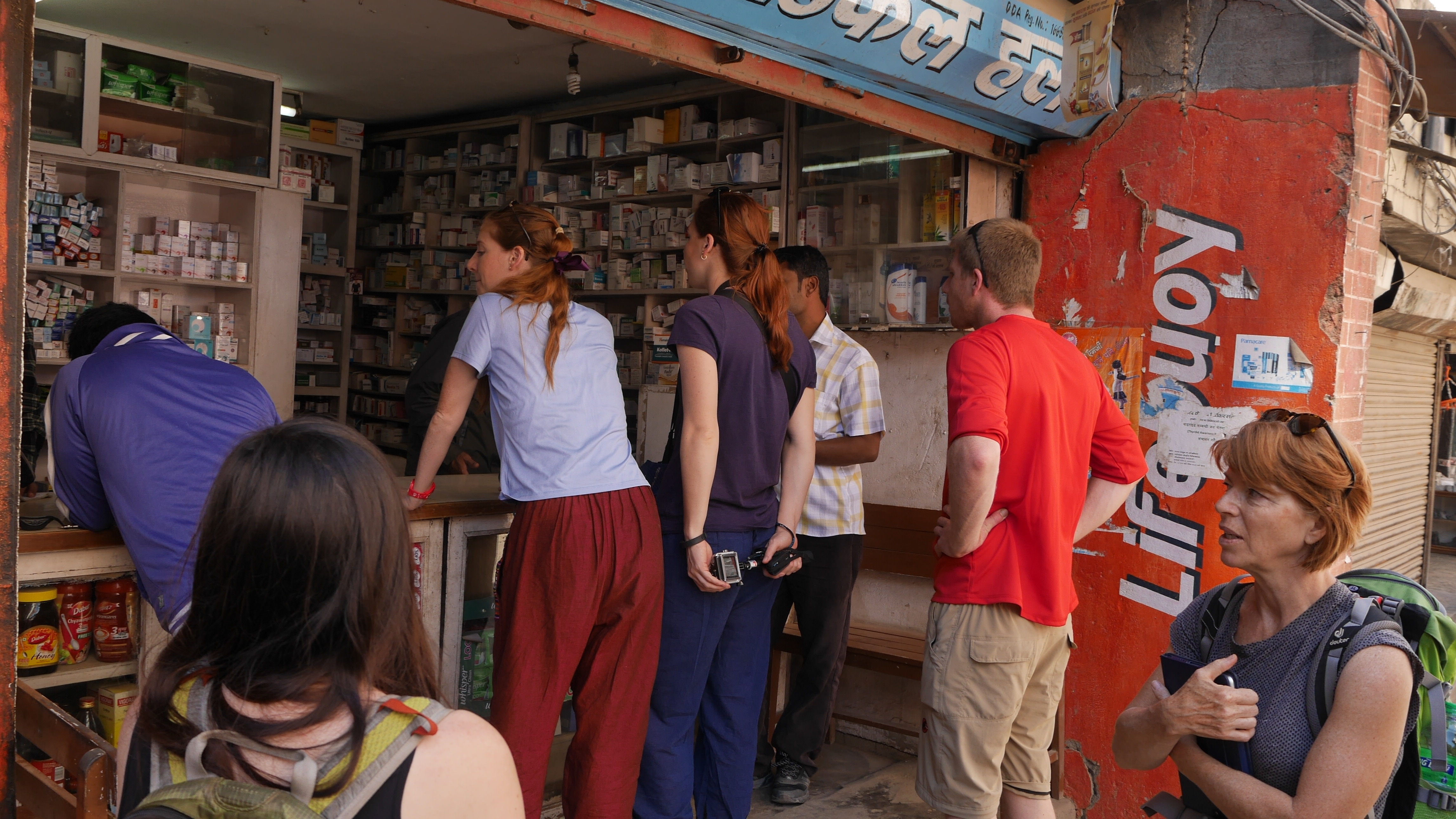
Annapurna Circuit
The trek we did was called the Annapurna circuit which is within the Annapurna mountain range of central Nepal. Its total length was 230km (145 miles) and rises to an altitude of 5416m (17769ft). It is voted the best long distance trek in the world due to its various climate zones; tropics to arctic and cultural variety; Hindu villages at low foothills to Tibetan culture of Manang Valley and lower Mustang.
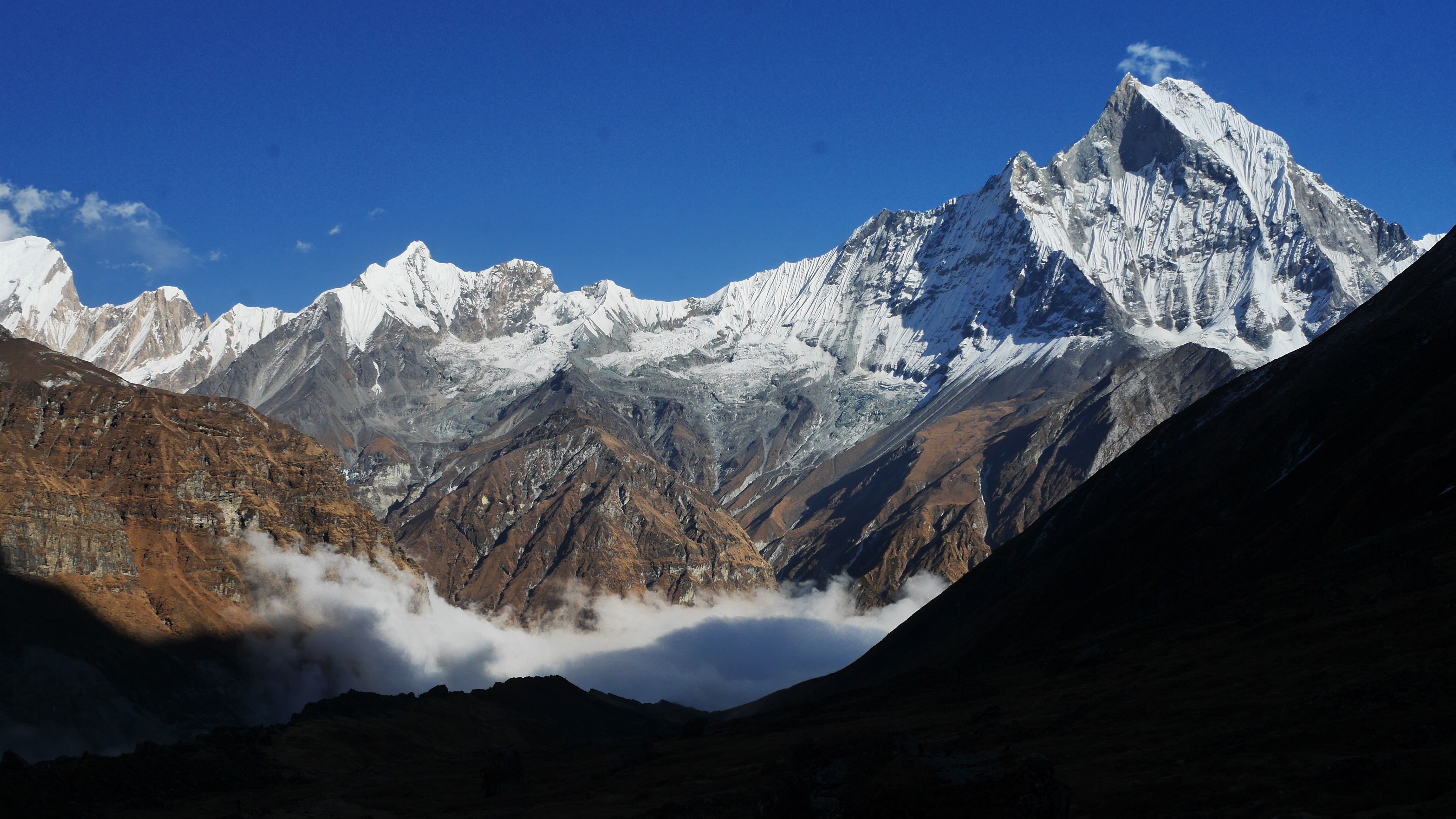
Our trek started very smoothly. We were all excited and full of energy ready to see the most spectacular mountains in the world. Between the seven of us we had one guide and four porters, each of which were literally half the size of us in both height and weight. It really made us feel slightly guilty for each kilogram we were over the ten kilogram weight limit. For the first few days we trekked numerous peaks and valleys at a lower altitude, wearing only shorts and t-shirts which were drenched in sweat by 4pm. The sun was harsh but when it set the wind was bone chilling, meaning we were wearing fleeces by 6pm and beanies and down jackets by 8pm.
Each day we walked about 6 to 7 hours, at an adequate pace and equal portions of ascents, descents and flat terrain. Every few kilometres we walked through cute little whimsical Nepalese villages, where the locals stared curiously as the tourists passed through. With a universal smile, they would quickly greet with ‘namaste,’ hello in their native language and then allowed us to refill our water bottles. The Nepalese people in these villages lived simple lives, which involved manual labour in rice and millet fields which was reflected by the multitude of lines on their faces form long hours in the sun. Houses were basic shacks with open fires located right next to the stable which housed their cows, buffalo and goats.

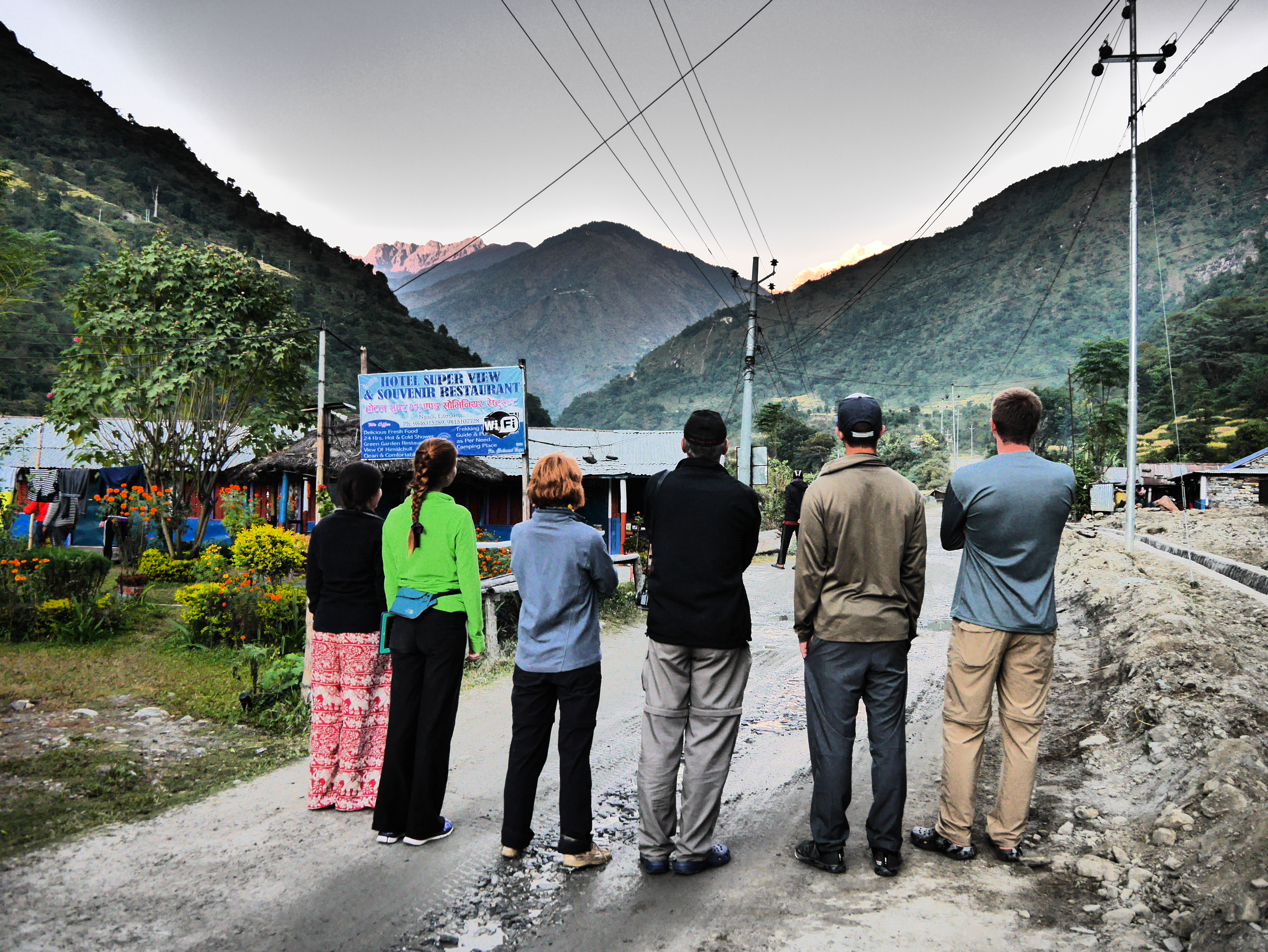
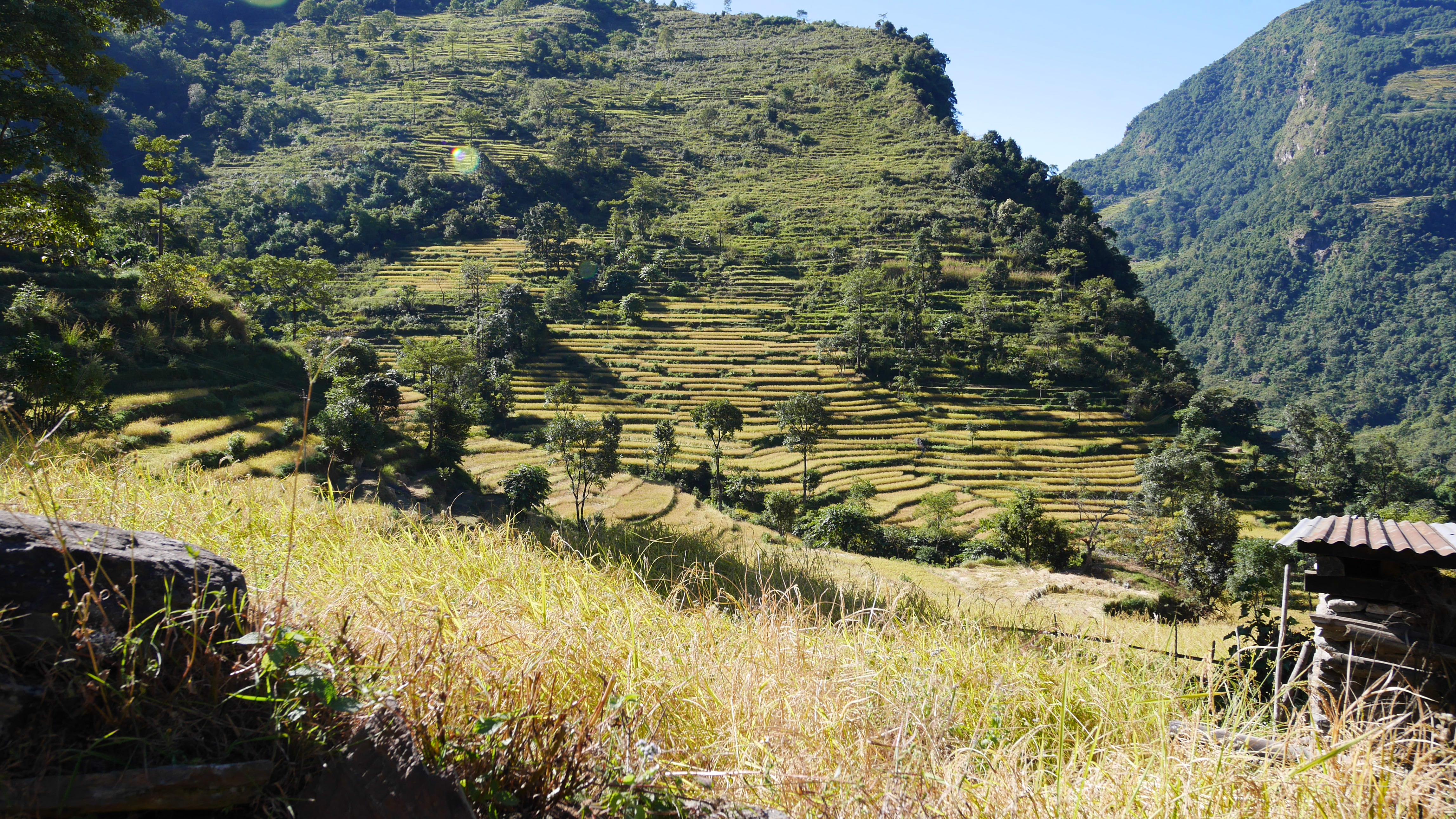
High suspension bridges frequently allowed us to cross large rivers, with gushing rapids that no raft could conquer. Some were low, others high, however each double bounced you as the porters hauled our gear behind us. While most were secure and safe, there were definitely a few which were one person at a time only, ensuring we stepped only on the loading sections of the struts. A collapse meant a certain plumage to your death. Waterfalls, rocky faces, prayer stations, water springs, blooming flowers and marijuana plants lined our path until finally we got a glimpse of the big boys, the mountains people come to see in Nepal. The intimidating mountains of the Annapurna ranges, cut the sky like a jagged shark tooth, almost blocking the remising sun in the late afternoon.
We upgraded from tents to tea houses on this vacation, meaning each night we had a wooden house, with a room and two beds in it. If we were lucky we had a light and power outlet. While running water was plentiful, a hot shower with a shower head that actually got you wet was considered luxury. Each night we ordered our meals off a menu, which despite the different location was identical each night. The menu got even more limited as we were highly recommended not to eat any meat, making us instant vegetarians. Any meat came from store fronts of the dusty roads in Kathmandu, meaning it then had to be driven for numerous days and even hiked in, depending on the road access to the village. For the first week we were all very diligent in doing laundry, mainly washing underpants and shirts that were beyond the smell check under running taps around the tea houses. Drying was always a gamble, often leaving us no choice but to become a human clothes line as we hung our gear from our packs as we hiked. This was of course nothing unusual for the Annapurna trekkers.
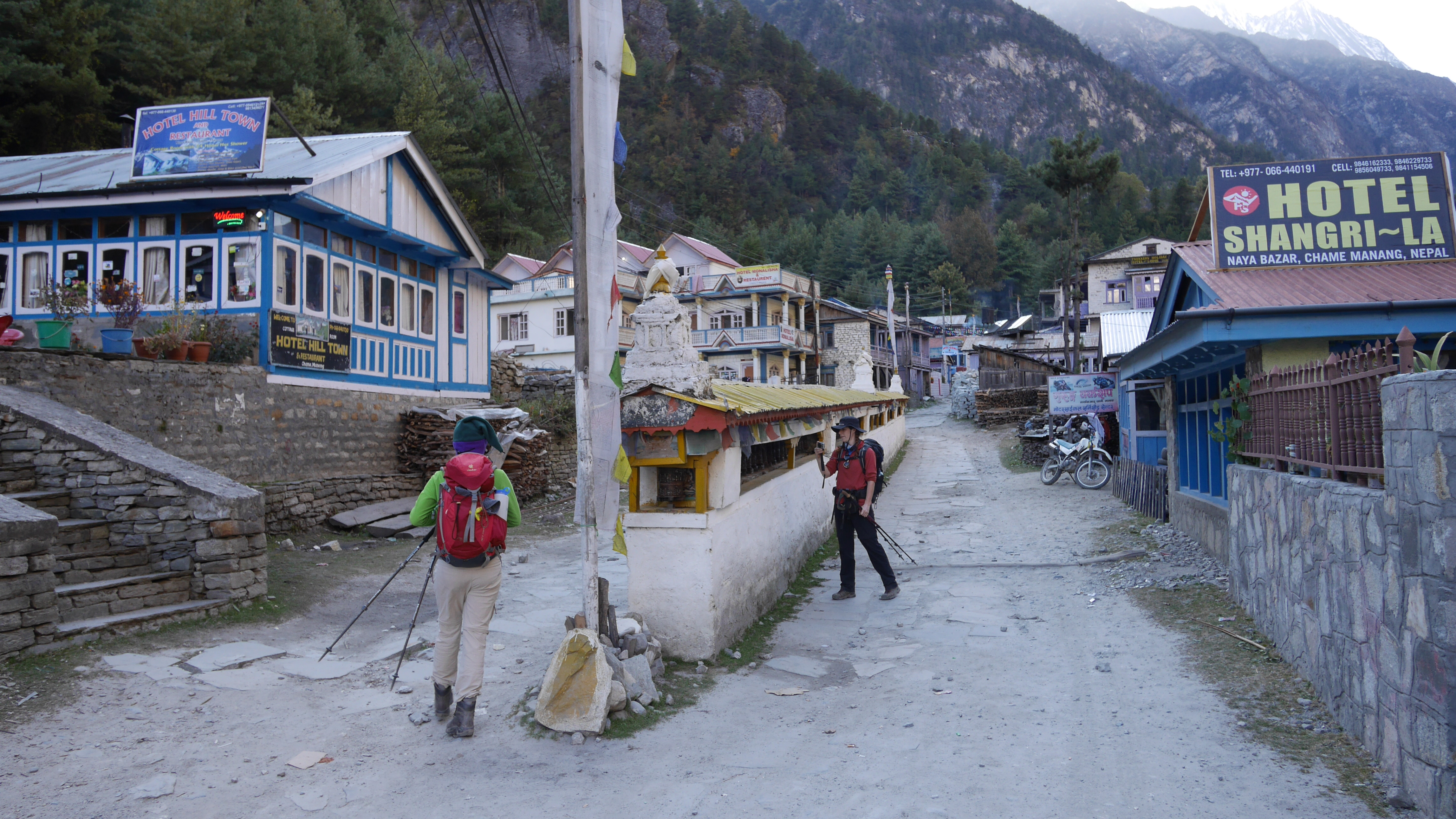
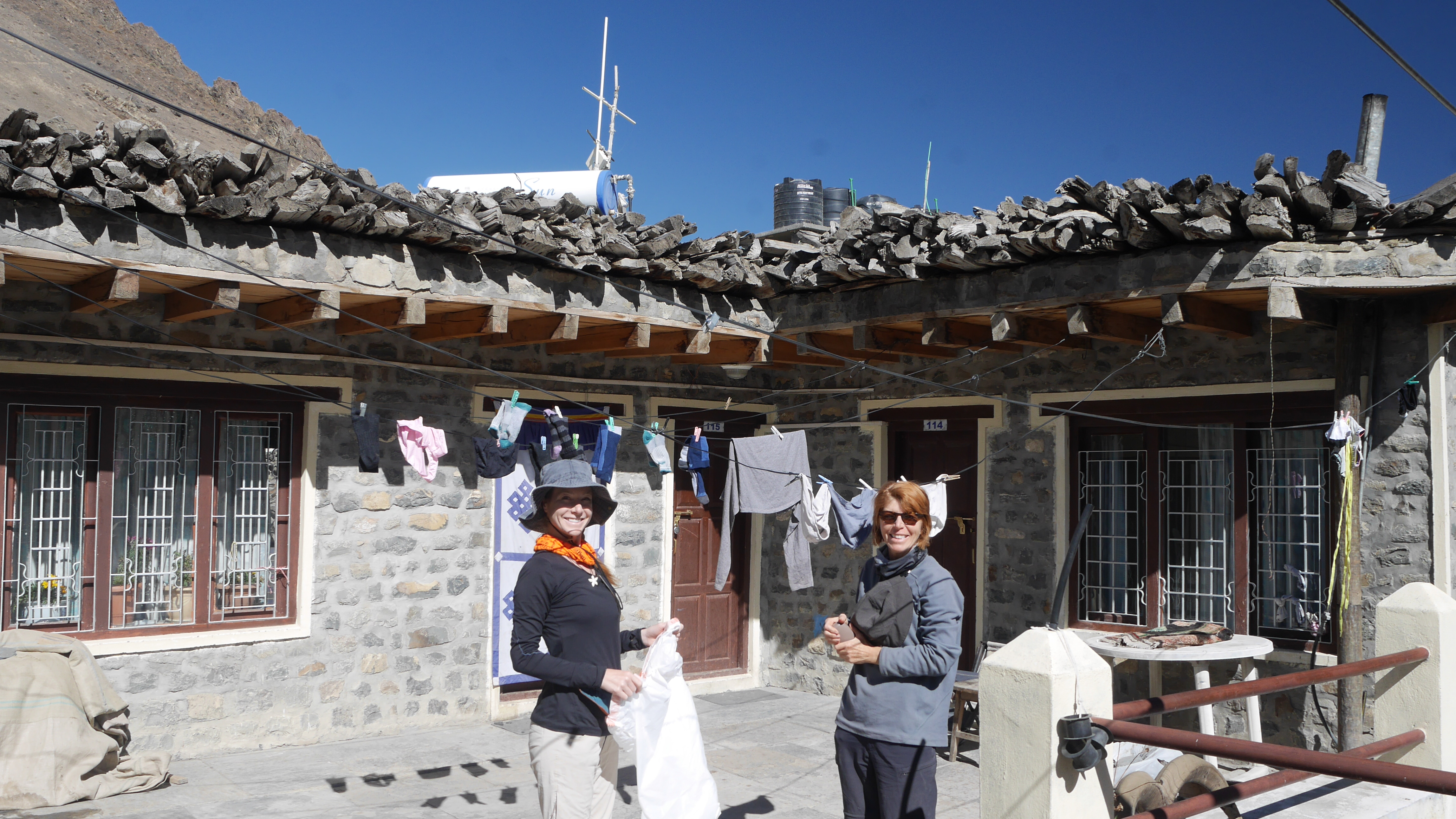
For the next few days the trekking continued. The higher we got the colder the mornings were, often leaving our laundered clothes frozen to the clothesline. The sun was still harsh and burned our hands as they grasped our beloved hiking poles. The tea huts also became simpler, the hot trickling showers which still left you with brain freeze were replaced with a bucket of hot water or just baby wipes. The temperature between in door and out was also minimal, the main difference remaining was the smell of fart. Above 3500m/11500ft is also where we came across the funny looking cows called yaks(male) and naks(female). They have huge bushy tails of hair all around their stomachs which almost resembles a skirt that sits just above the ground. The yaks are essential for transporting gear to the higher villages as they are naturally acclimatized for carrying heavy loads at high altitudes. Unlike horses or mules, their rounded cloven hooves can grip the ice and snow. Ultimately yaks were our piece of mind-our emergency mode of transport across the pass if one of us got sick.
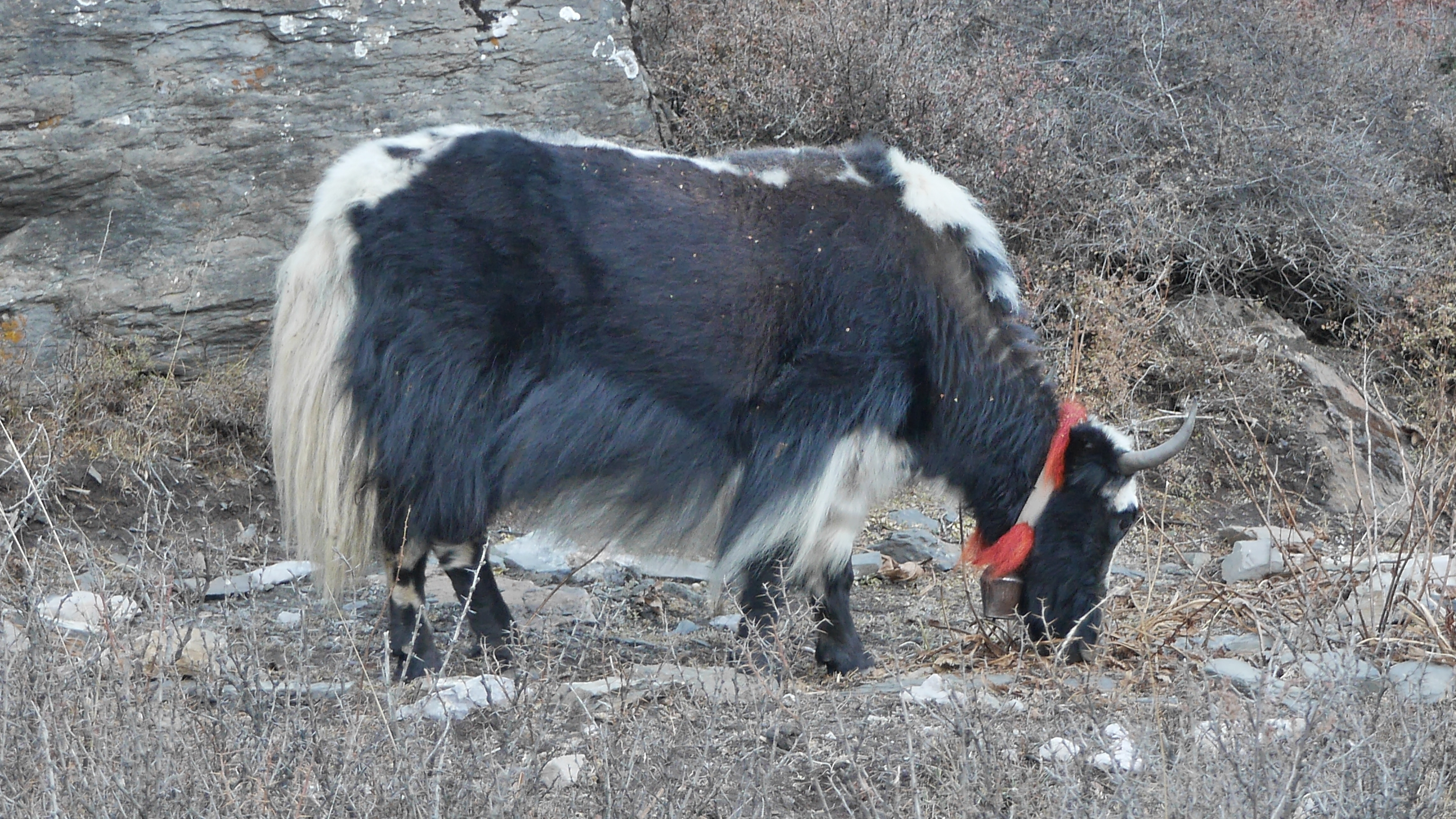
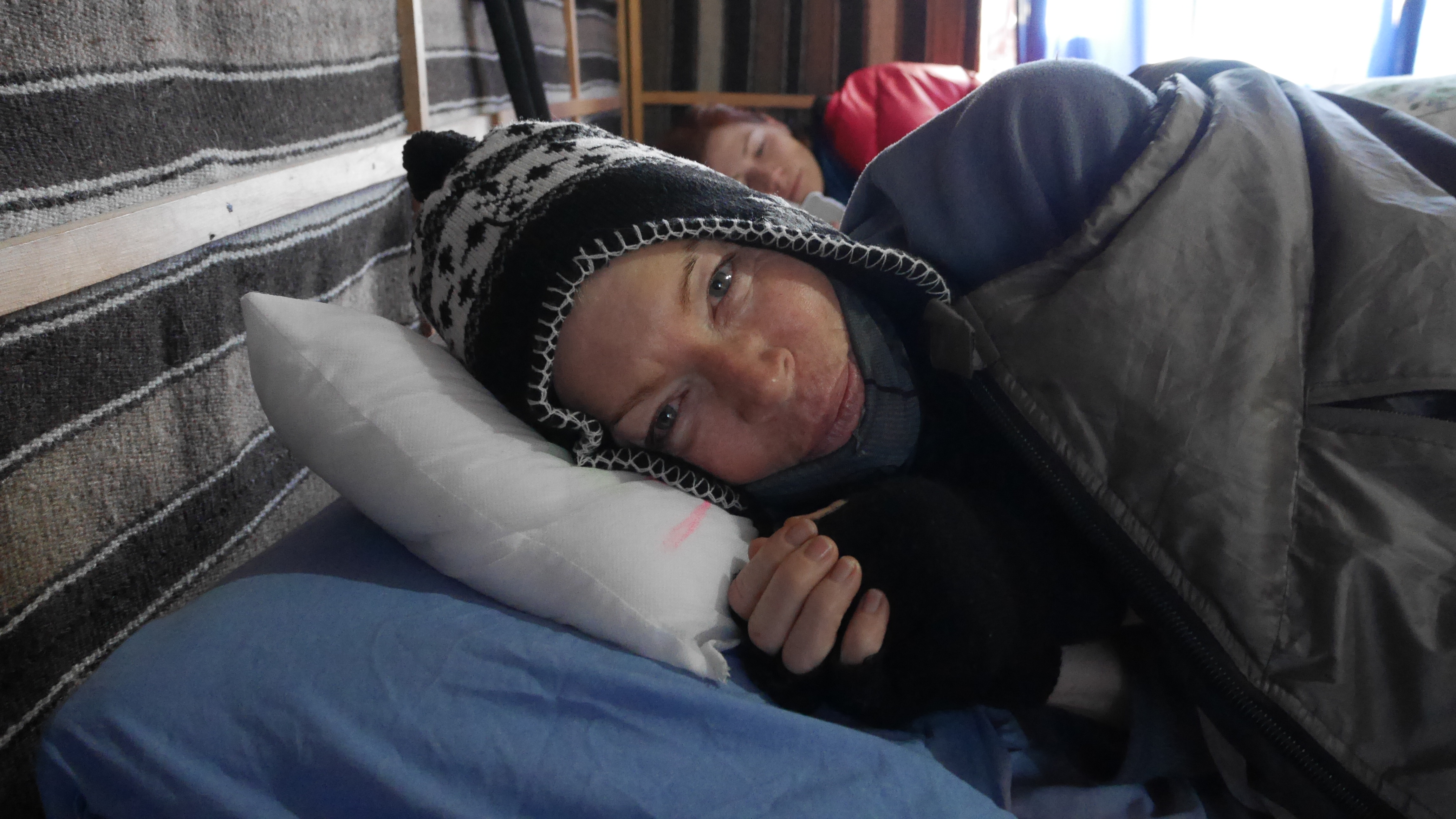

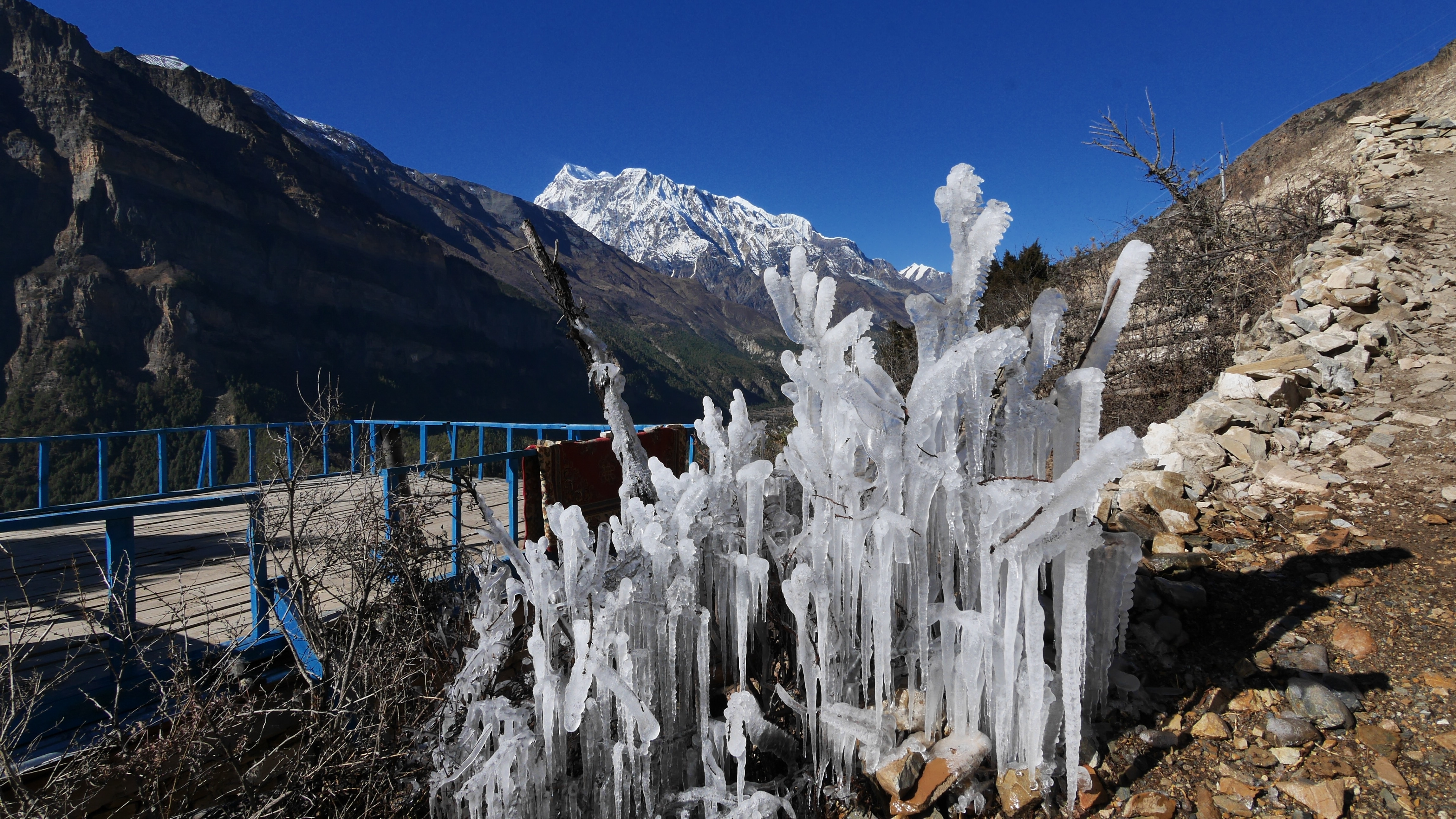
As I mentioned earlier, for the 21 days the menu was the same, the concept of fresh fruit and vegetables didn’t really exist. We would have potato curry, fried noodles, momo (dumplings) or dahl bat (traditional Nepalese dish) or something similar of the sort. I think we all knew the menu by heart at the end. Water was everywhere, springs and rivers from the mountains ran through the villages through rigged primitive hoses. The taps were always running, presumably to prevent the build-up of bacteria and stop it from freezing. The water looked clean in our bottles most of the time, sometimes there were floaties, rocks and most likely a few amoeba as Graham would say, which we camouflaged with Gatorade powder. To be on the safe side we did always used water purification tablets (troclosene sodium) and tried not to look too closely.
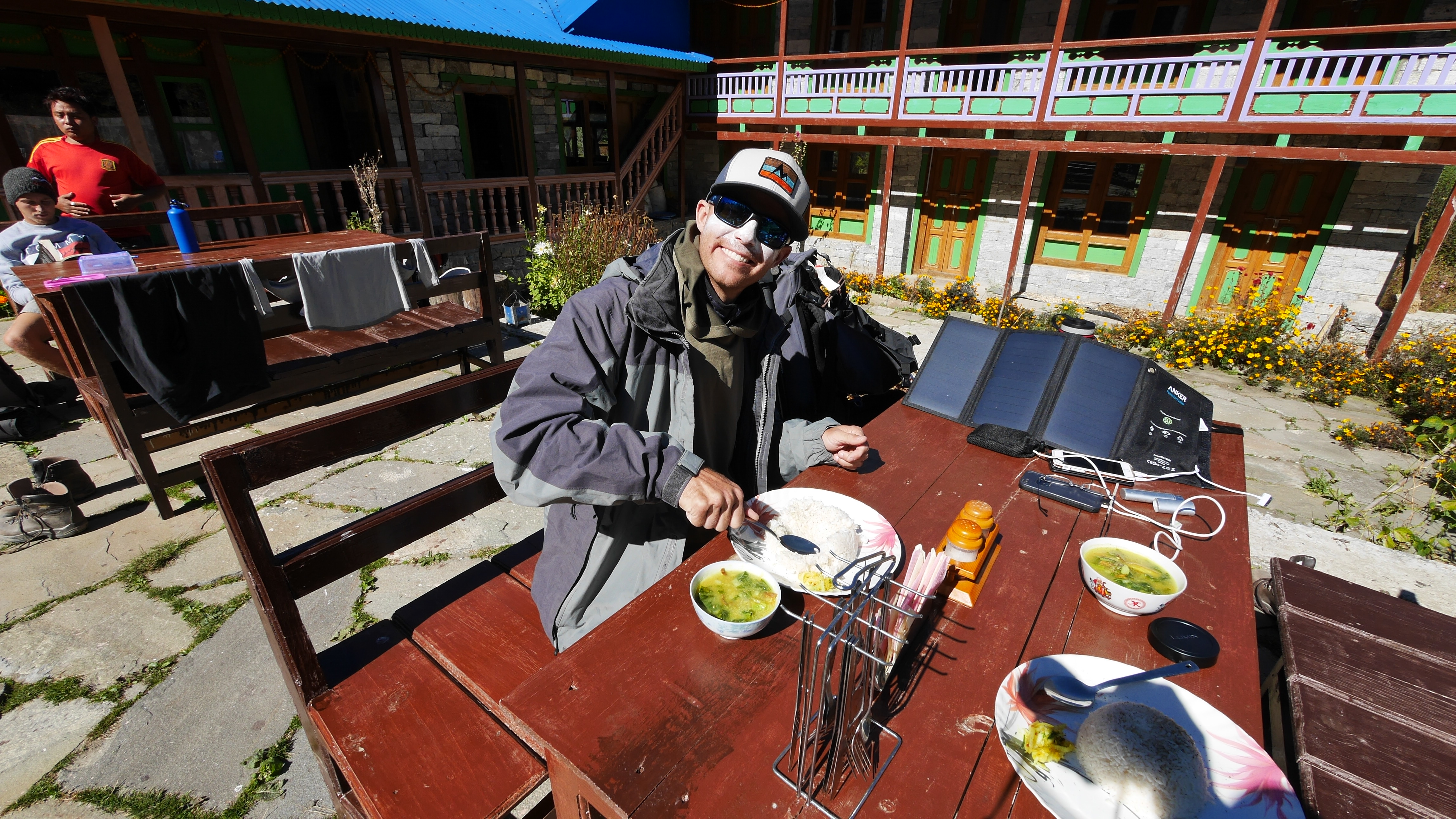
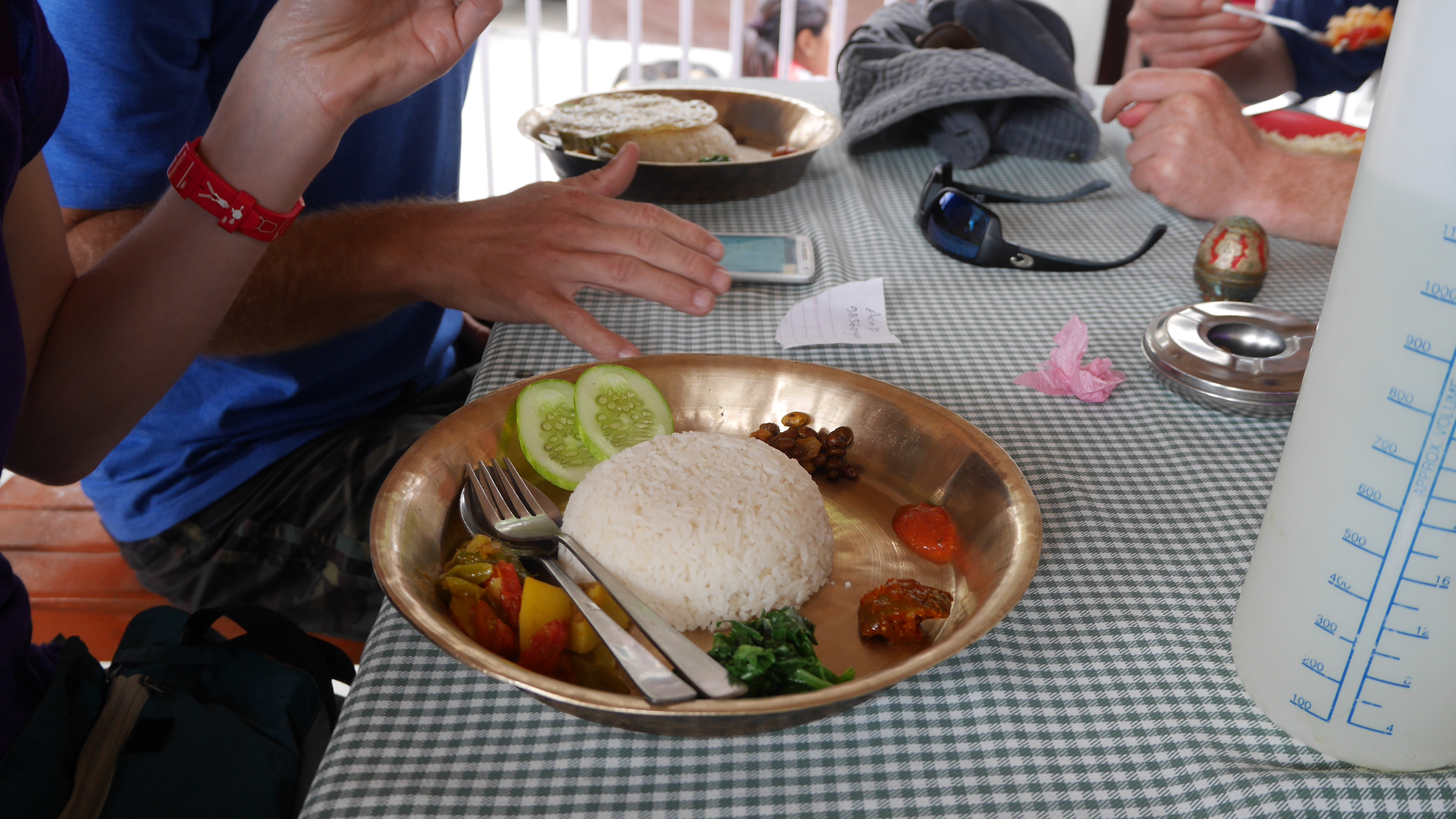
The seven of us were certainly not the only trekkers on the circuit. There were about 20 others that started the same day and we would randomly run into them in the villages. If not in in the same tea house, in one further down. We also met new trekkers a day in front or behind their timeline, so faces started to look familiar. Funnily enough most of the trekkers were young, between the ages of 18 to 35. Big groups of youngster both prepared and unprepared trekked along without a care in the world. Many were from Australia and Switzerland, a few Canadians, British and other regions of Europe. Americans were few and far between.
Two days before the big Thorang pass I ran into another shitty situation. The bug from Kathmandu or something else had returned twice as bad. I was spouting bodily fluid from every orifice. I could literally squat to poop and bend over forward to puke in one smooth motion. I had to get out of bed over 20 times each night keeping both Graham and I awake. By the second day (the night the before the summit) I was so weak I almost fainted trying to stand from the squat toilets. For those who know me well, I rarely get sick, if I feel awful I just usually just tough it out. This was quiet easily the sickest I have been in my adult life and all I wanted to do was cry in mums nurturing arms. Everything hurt, it felt like every muscle had taken a beating, worse still was the fear of defeat knowing I may not make the 5416m/17769ft pass at three am the next morning. All I could hope for was that the day two of antibiotics would finally kick in.
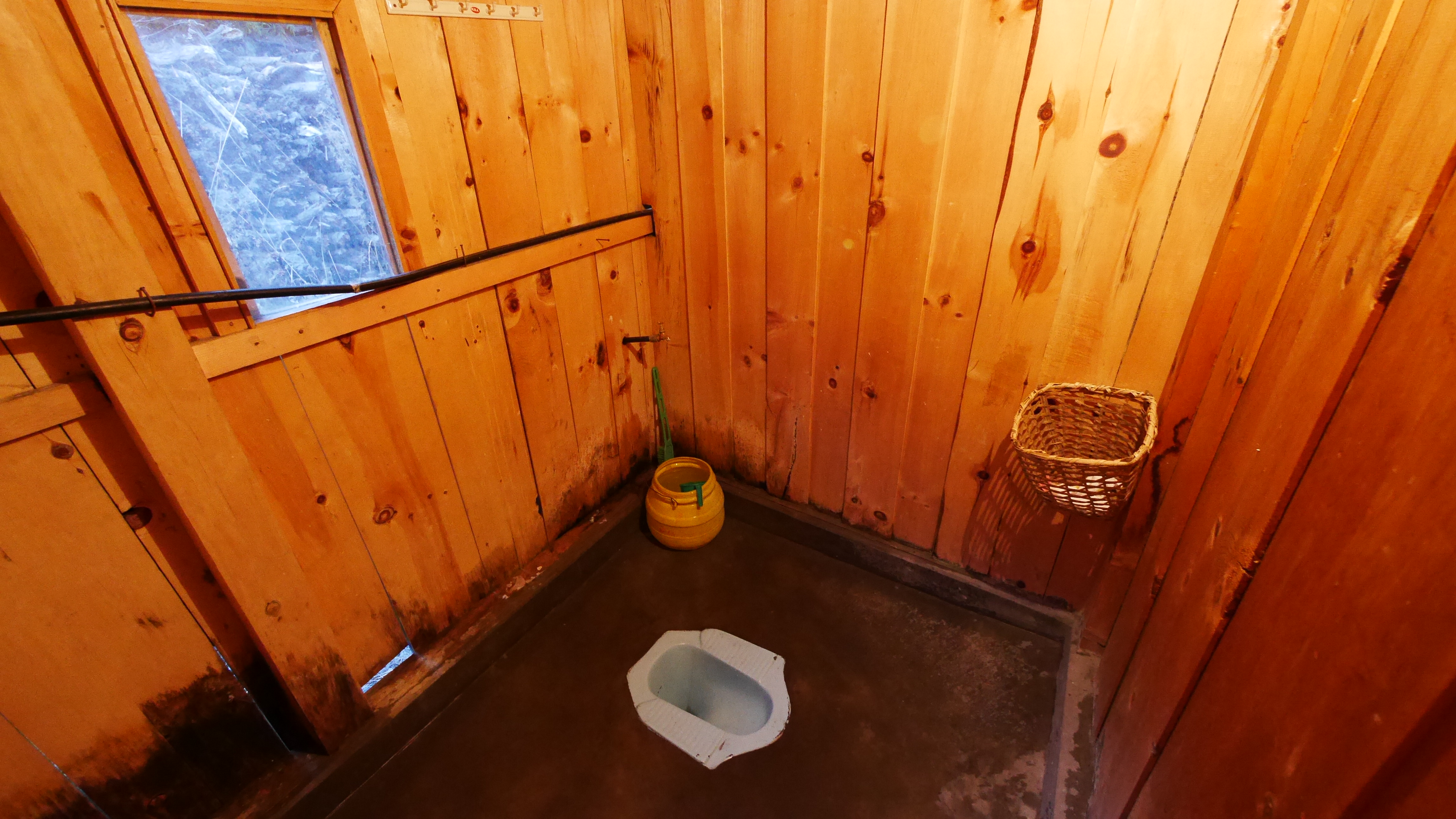
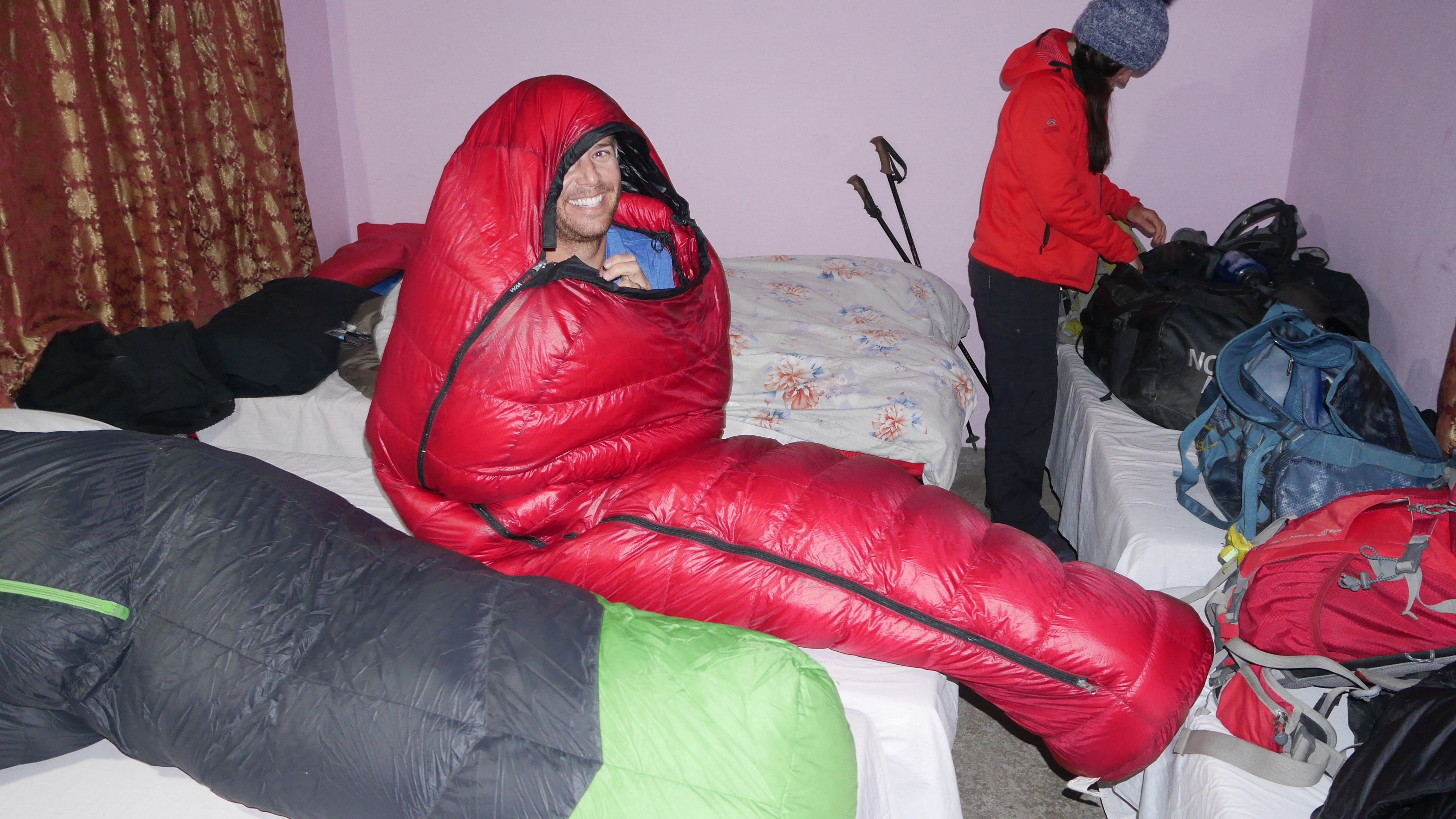
Thorong La or Thorung La: Mountain pass with an elevation of 5,416m/17,769ft above sea level.
The pass started with a 3am wake up call. I had managed to get through the night without getting up and was 70% better. The body aches had reduced and the diarrhea seemed to have stopped. I certainly didn’t risk passing gas. Due to my condition the previous day my mum had hired a horse just in case I had to be carried. Luckily I didn’t need it, however my sister and I did take a 20 minute joy ride earlier during the hike. The horse was fast up the mountain, presumably so it could go back down and collect more people for more money. We made our horse guide so mad because we made him wait for the group. As we walked off we heard him cursing into the night. While the horse was not needed for me, it did come in handy for some of the rest of our gang. While I was the only one with gastro, there were definitely some colds running through our group. Philippa and my dad were the most affected making everyone cringe at the sound of their coughs.
Climbing over 5000 m is never easy and I really don’t think you know this until you have done it yourself. Being our second time or third in some cases we had a fairly good idea of what to expect. Surprisingly I found the strength and breathing not to be the issue, however like on Kilimanjaro my hands were like icicles. They hurt so much I had a mini fit, and almost started to cry. My sister was also not helping with her stories of how her friend got frost bite. My solution ended up being ditching my outer gloves and poles at Graham’s feet, putting my hands in my down jacket pockets and charging off up the mountain to where the sun was slowly rising. Five hours later we finally reached the summit. When you reach that final stretch, the intense feeling of the heart and mind are more wonderful than the best words or image can describe. My mouth instantaneously starts to grin and it feels like the butterflies jump up and down in my chest and stomach. It is the strangest feeling of happiness and accomplishment.
The rest of the family arrived in stages. Our pace was not dictated by our guide. He stayed with mum who was mostly the slowest. My brother was once again a freak of nature-he ran up behind a horse to the top. Being Philippa’s first time she probably had the roughest time. Her cold, which had stuck with her from the first day definitely did not help. She also got pushed over by a horse on the way up as it was passing on the narrow trail. While the horse helped with getting her over the pass, it also made her extremely cold. On the descent I think she was almost hypothermic and having chest pain. While we were all still in gloves and down jackets, she only had her windbreaker on. Finally, we helped her put her warm gear back on and after some help from the guide to a lower elevation, recovery was fast.
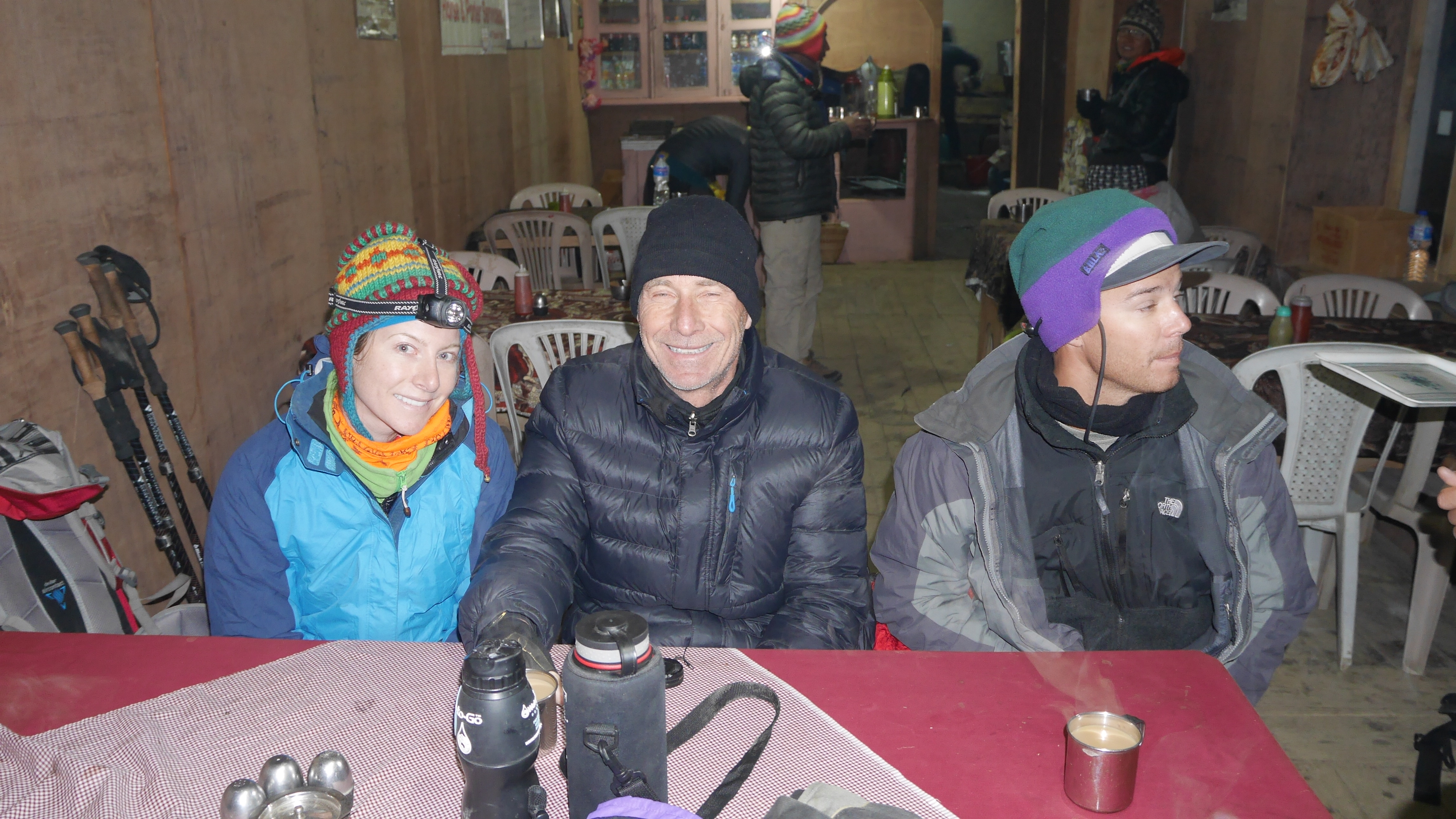
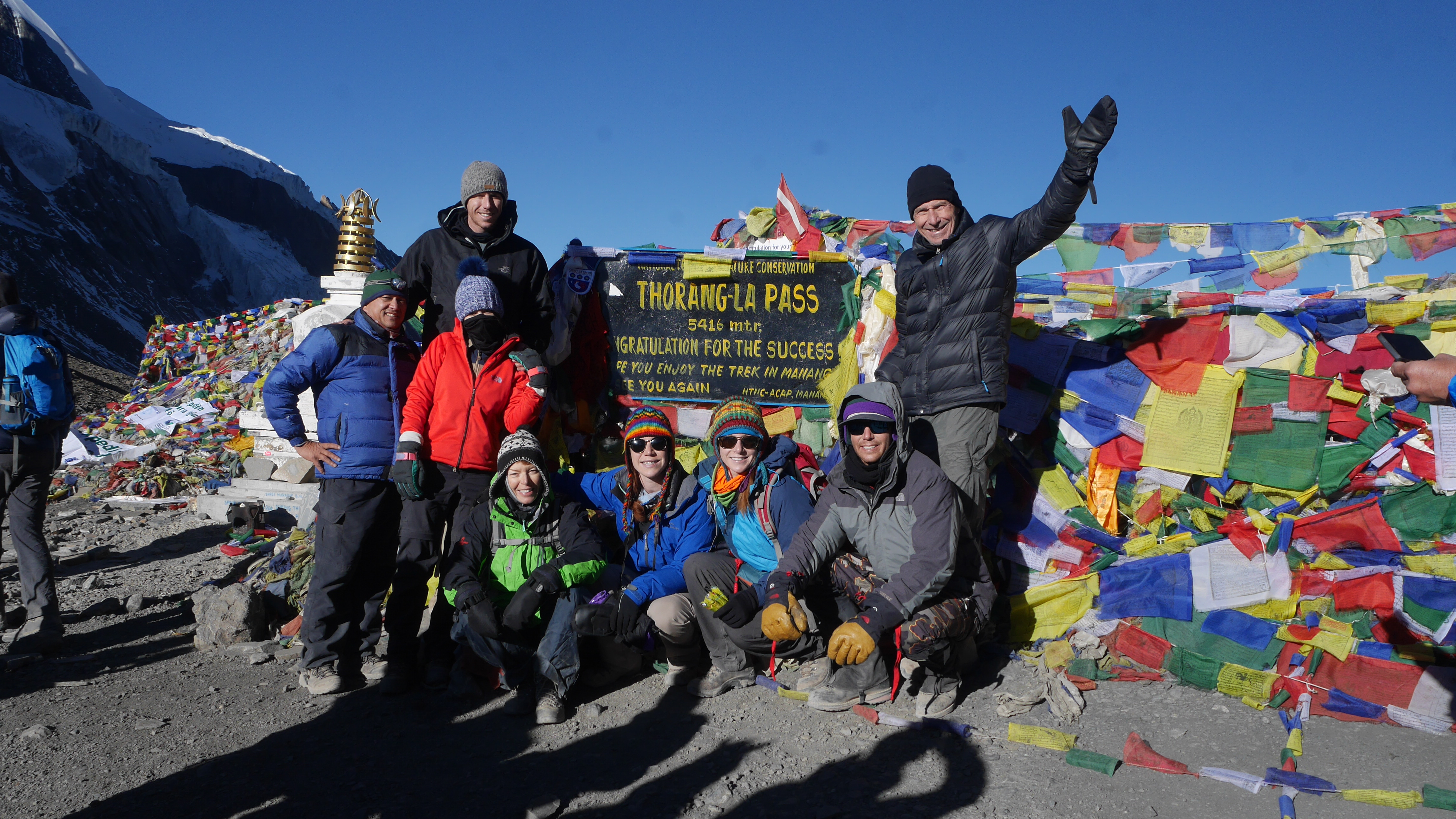
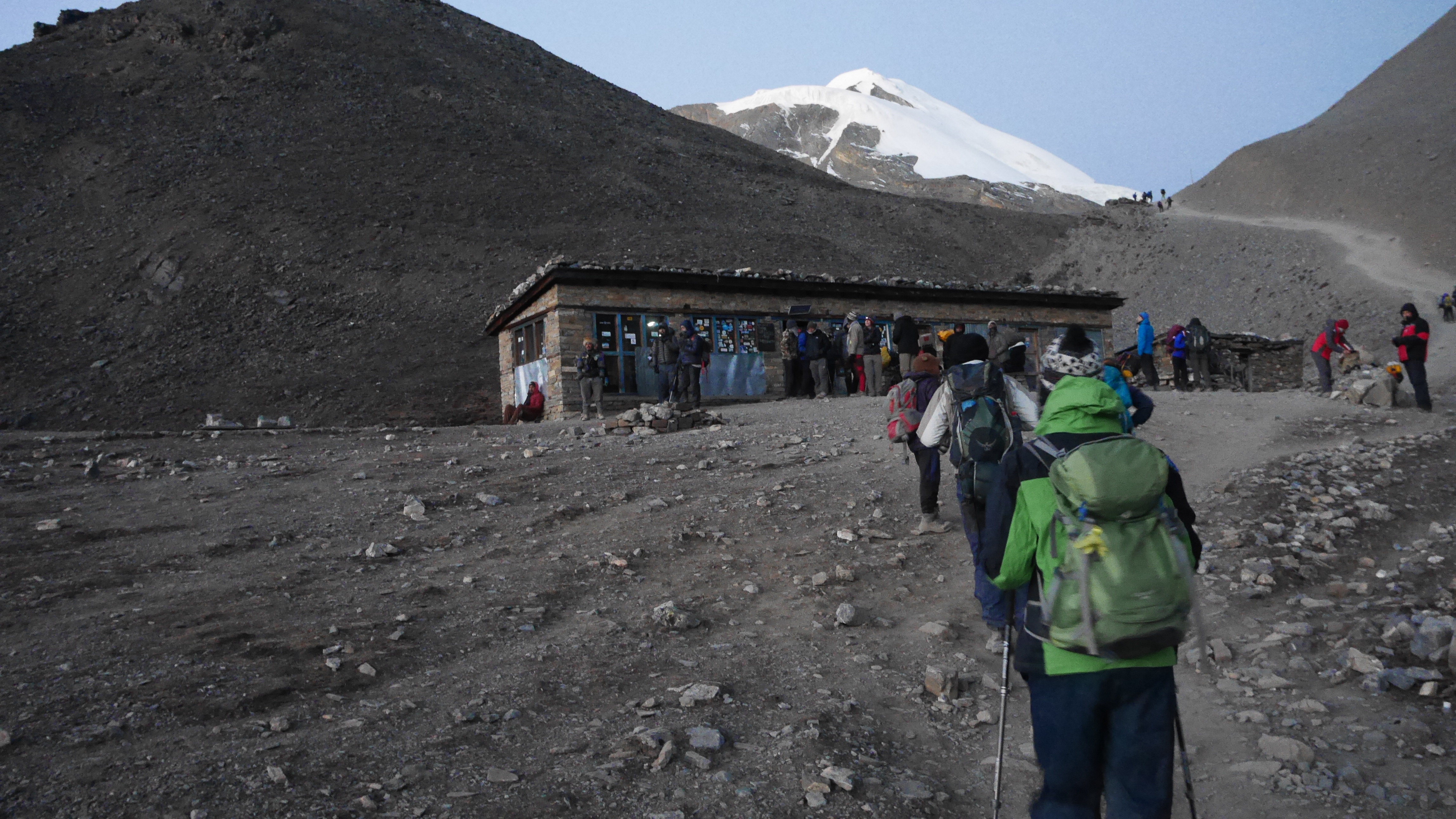
Mustang Valley
The circuit continued with no rest. The following day we clocked a huge 25km/15.5miles. We passed through the Mustang valley where we were told it would be very windy. We kind of just blew off the windy warning, thinking it would be no big deal. To say the least our buffs stayed on the entire day and we would have been blown over with a lapse of concentration. No planes were allowed to land or fly out after 10am due to the strength of the winds. On this day we also visited the border to Upper Mustang valley which divides China and Nepal. This area had very strict rules and regulations as well as expensive permits. It only had 1000 visitors per year. In the Mustang valley each wife also has two husbands, a nice change to the norm in many cultures.
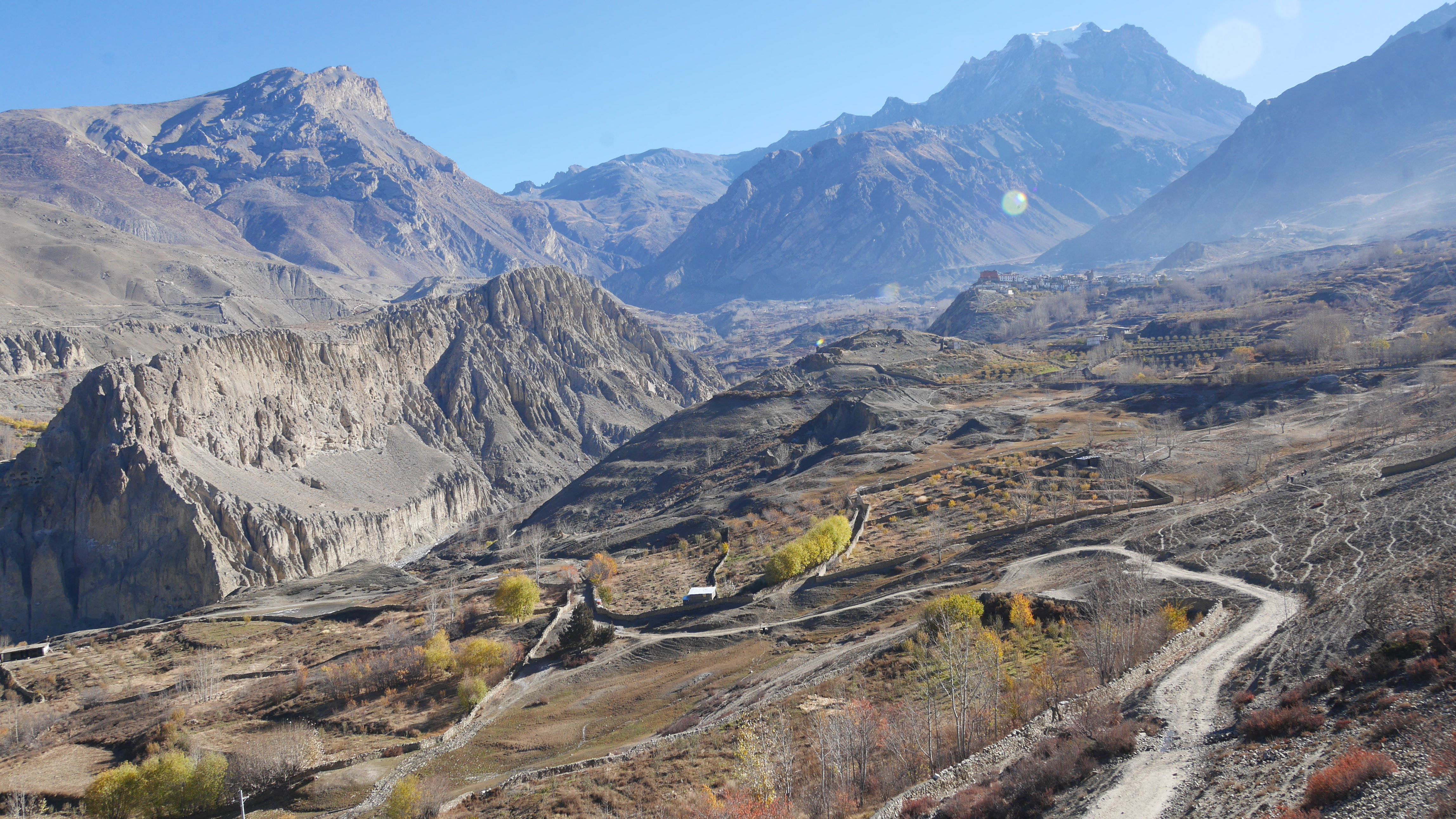
Short cut to the hot springs
The Annapurna circuit usually takes 25 days. Due to its increase in popularity, numerous dirt roads have been created to supply the villages with the increase in demand. To avoid walking on unpleasant dusty roads we decided to add in one jeep day, which cut three days off trekking. The jeep ride was horrific and scary. It took a whole eight hours to drive 60 miles. It made the jeep tours that you pay for in Colorado look tame. To make it worse, we rode in typical third world style and had 13 people crammed into this vehicle. At one time I hit my head so hard I had tears in my eyes and had to ask my brother an hour later if my pupils were still the same size. Luckily our next stop at natural hot springs, allowing us to relax, dissolve the dirt under our fingernails, soak our sore muscles and for the first time drink a few beers. The hot springs were amazing on sore muscles, but more so, great for showers. We too lined up with the locals for our first proper shower in two weeks.
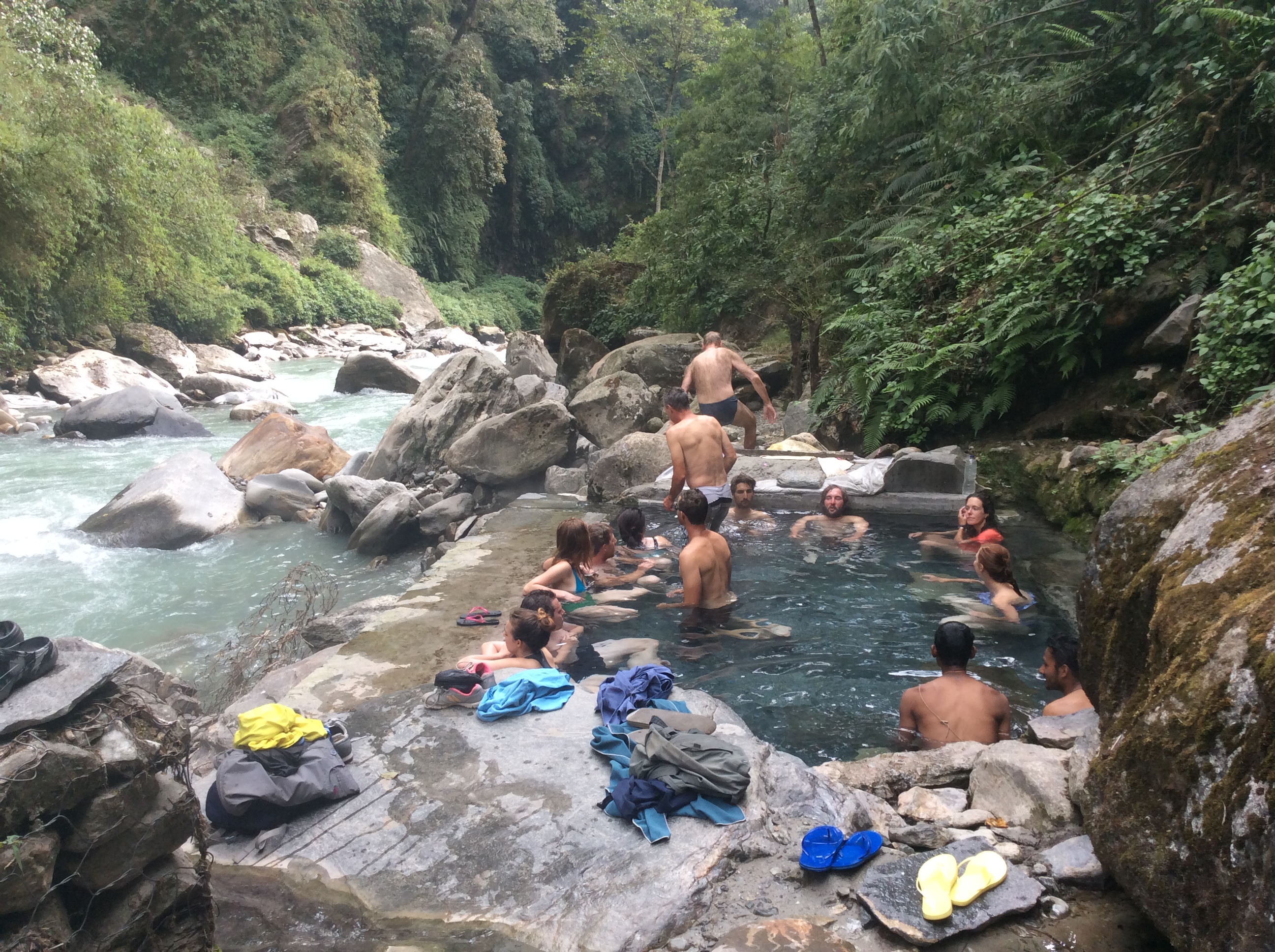
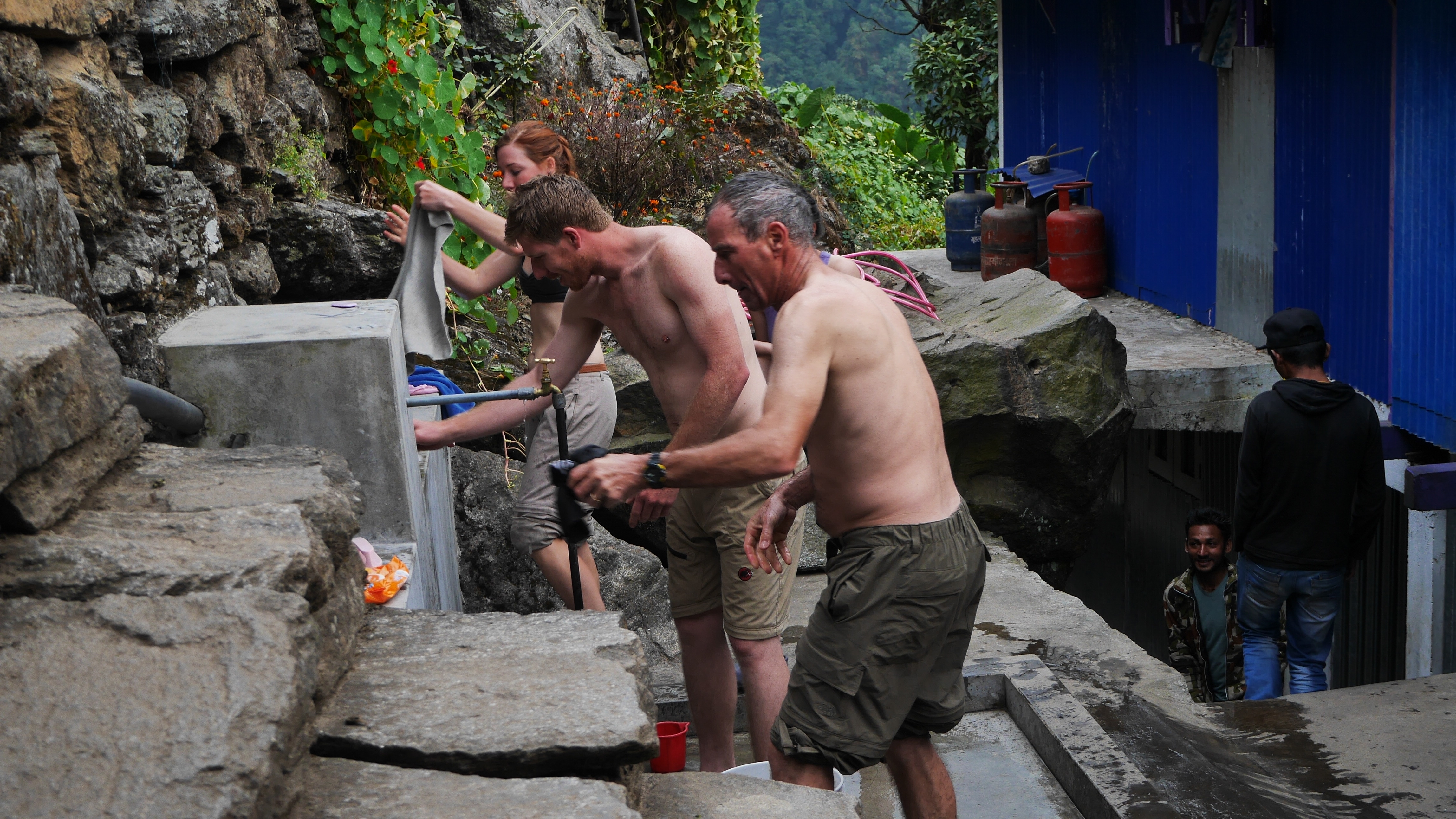
Return of the appetite
The hiking continued, we stayed in larger villages where we ate meat like starving lions and smaller villages with two three houses where we crammed in to snuggle around the fire. While the next few days were challenging (going a mile up in elevation in one day) it was hidden by the gorgeous trails through the hills and forests. With the high pass behind us we trekked forward for Annapurna Base Camp, also known as ABC. The trials went up and down all day, at times scrambling up rocks, over questionable ladder bridges or just waterfalls themselves. With 8 hour days of trekking we were always starving by meal times. This was a strange feeling for me. Embarrassingly and also gratefully I don’t remember the last time I was hungry for every meal for weeks on end. Graham’s favourite was always Dal baht. It consisted of a huge portion of rice, lentil soup, curried potatoes and beans, a pickled radish and some sort of sautéed greens and it was endless. You could eat as much as you wanted and it was always fresh. Graham was the dal baht disposal. He ate it every day, even after we watched a cute little kitten use the open rice bag as a kitty litter box.
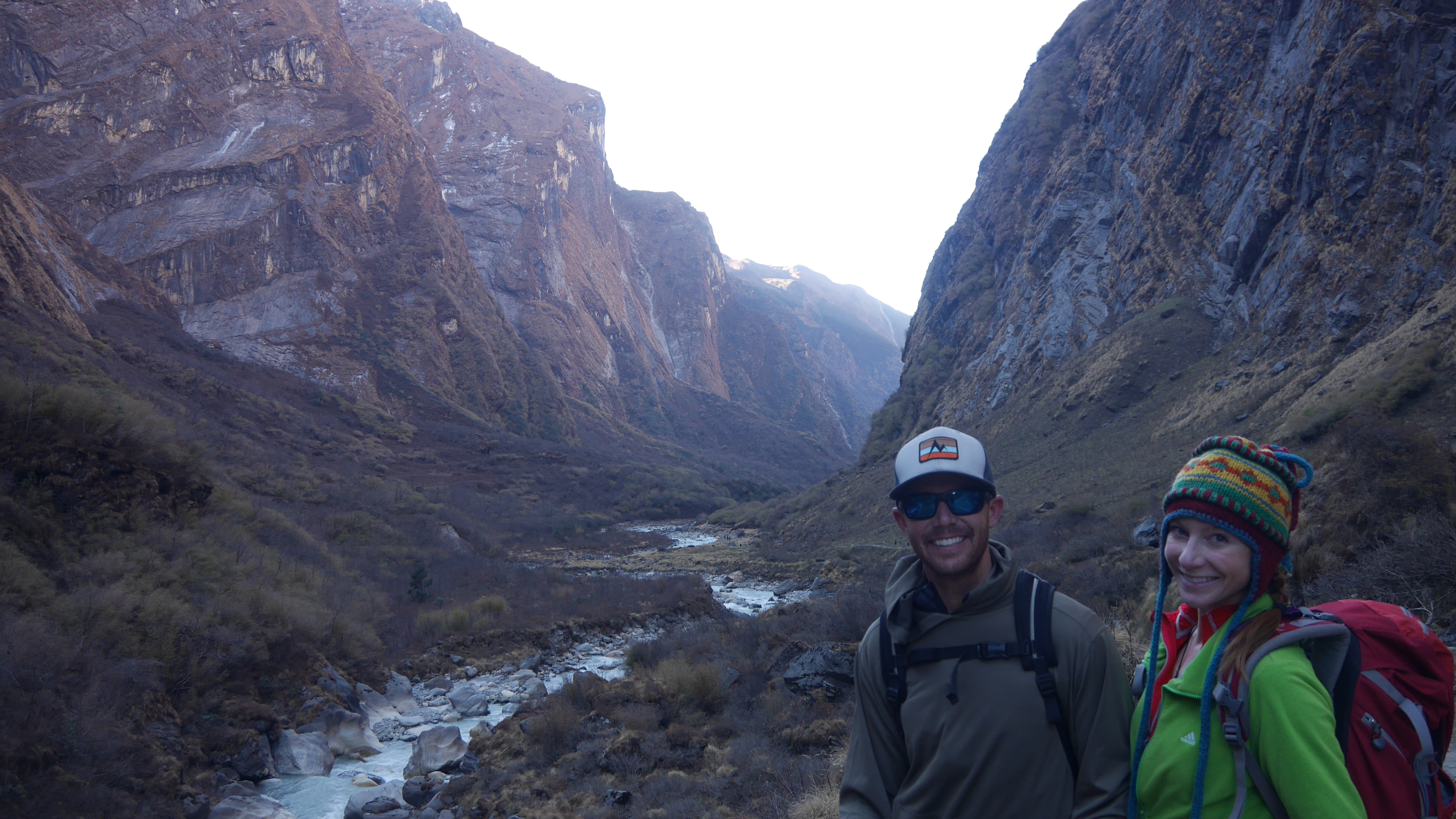
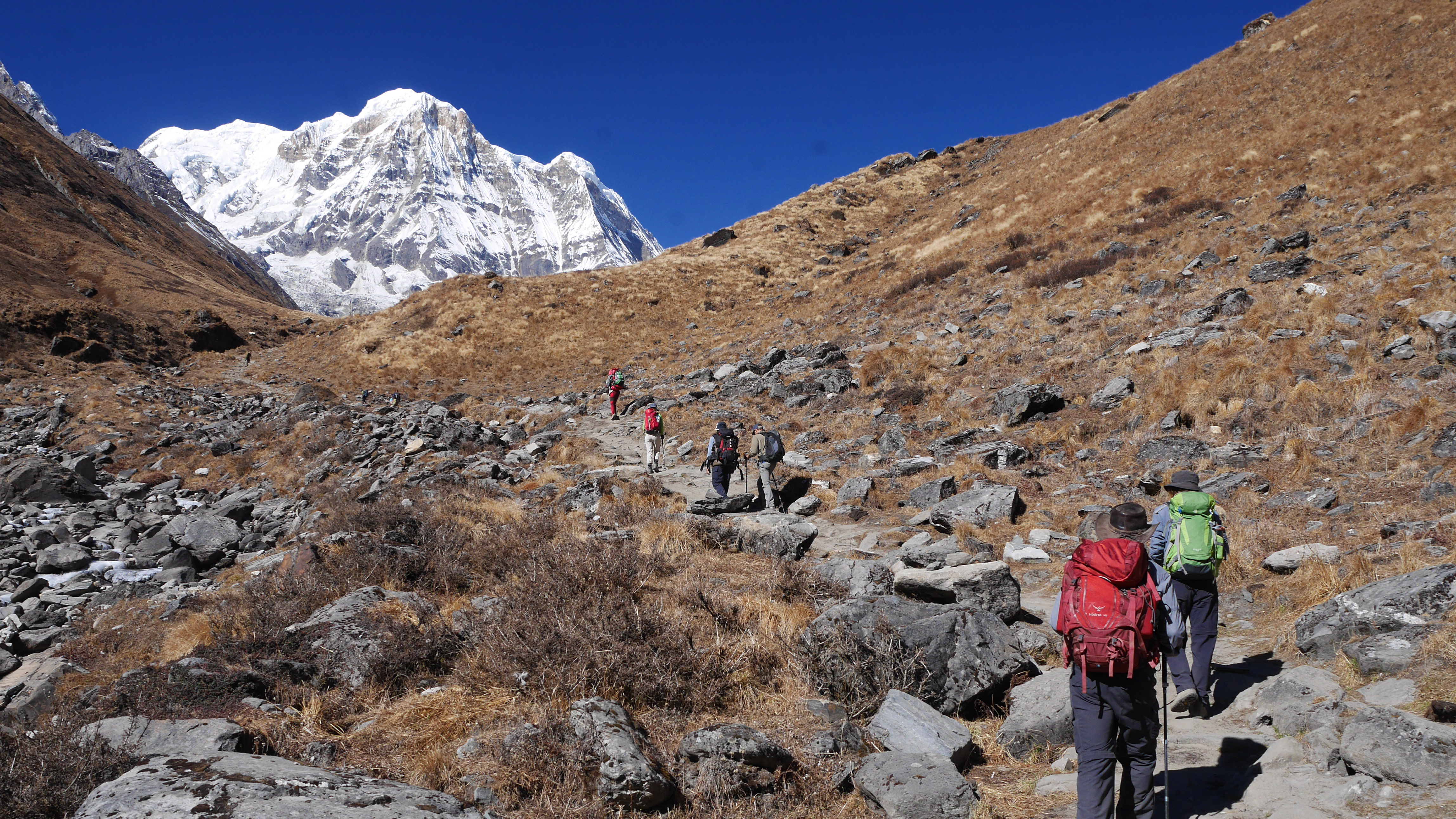
Annapurna Base Camp
On the second half of our trek, we lost most of the trekkers we had become familiar with at the beginning, most don’t do both the pass and ABC, even our porters and guide had given us some alternate options to our original itinerary, likely because they knew the uphill routes to come. Of course our mind had not changed. We had seen the Annapurna range from the outside in, now we wanted to see it from the inside. ABC also known as the Annapurna Sanctuary did not disappoint. The thigh burning climb, which caused you to sweat in a freezing wind chill rewarded us with mind blowing 360 degree panoramas. Annapurna South was so close, teasing us with its dazzling beauty despite being one of the most dangerous mountains to climb. Annapurna 1 is regarded as the most difficult and dangerous of the 14 highest mountains in the world. It has the highest fatality rate amongst mountaineers. We watched the sunrise and sunset changing the colors on numerous icy peaks around us. As you sat there looking up, you could hear the mountains speaking, crunching or crackling in every direction. You lost yourself in time sitting there, speechless at their presence. Looking down at where we had hiked from, there was a blanked of clouds blocking the exit. We were in our own world up there, cut off from the world which was far from our thoughts by this stage. Leaving ABC the next day was a sad realization that we all had to start heading back to earth all too fast. Three days of uphill equated to one day down hill. While I am normally an expert when it comes to down hill, the ginormous steps, rivers and boulders left us all with sore and quivering knees after 6 hours. I rolled my ankle exactly eight times, luckily saved by my boots which now have well over 300 miles on them. After each hour of downhill I could hardly believe our legs had carried us that entire way up. Our only distraction was my sister and my dad who were debating quite strongly the stories of Jon Krakauer verse Anatoli Boukreev as they had decided to read a book each along the trek. An appropriate selection definitely, made even more realistic with the numerous memorials of Anatoli at ABC, where he had met his death on Annapurna 1 in 1997.


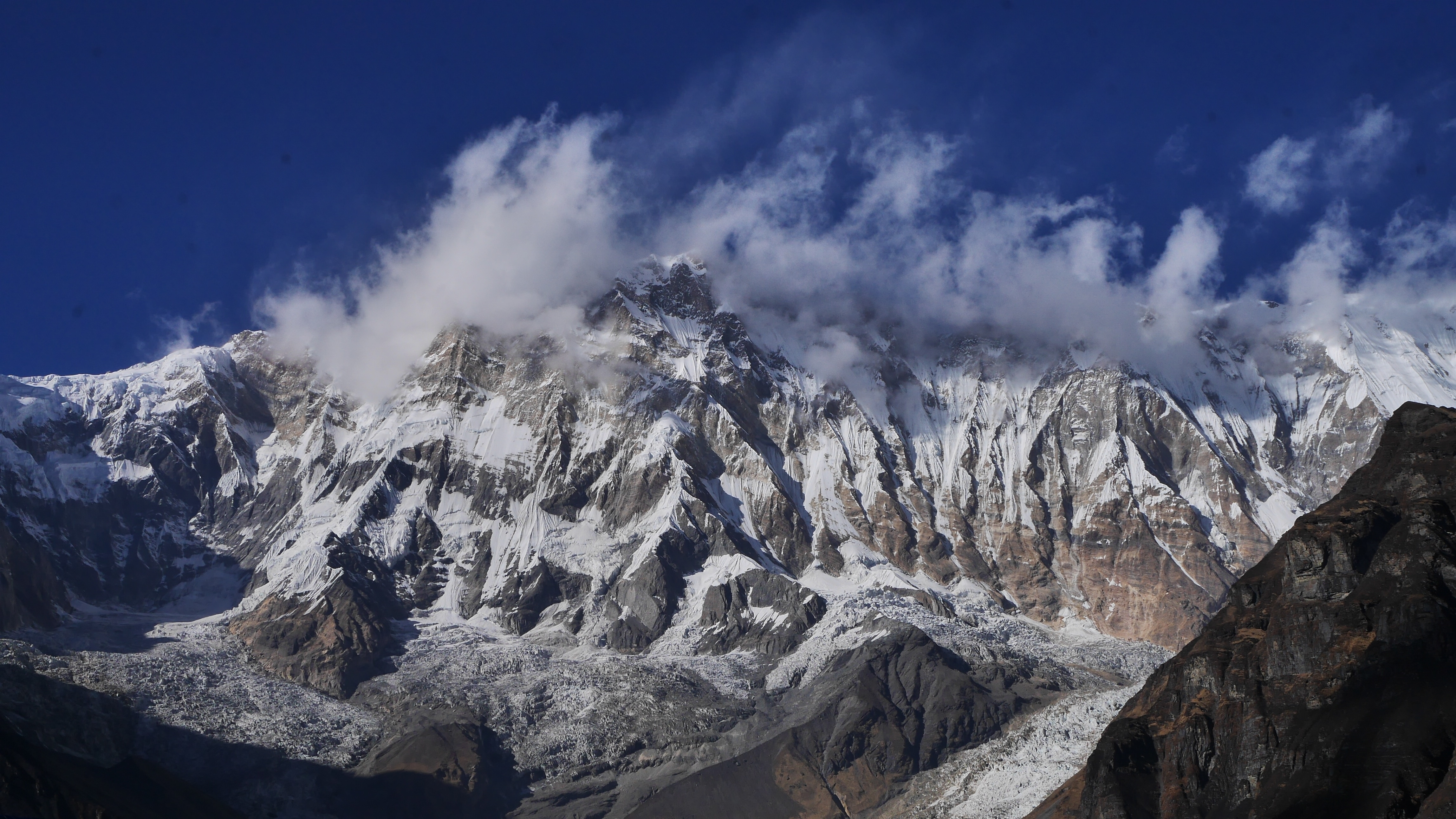
Pokhara
Reaching Pokhara meant the end of our three weeks of trekking. It also meant looking in the mirror for the first time, eating meat, finally being able to shower and sit on a toilet without pee spaying in your boots. Our bodies were all proudly transformed, despite the piles of carbohydrates we ate three times a day. Pokhara was similar to Thamel in Kathmandu in many ways. Lots of tourist shops selling trekking gear and other trinkets that always lured you in. As you walked through the dusty main streets, you once again heard the gross but familiar sound of people pulling loogies to clear the inhaled dirt from their throats. It was here we said our goodbyes to our guide and porters. Despite a generous tip they still hung around for a few meals on us. We joked with them saying you can order anything- just no meat, as this was our rule on the mountain. It was warming and satisfying to know they departed happy-having worked for the last month and surviving with all our diverse personalities.
My family departed from Pokhara to return to Australia shortly afterwards, however not before a few massages, facials, celebrating Graham’s birthday and bungee jumping. During bungee jumping I had every possible scenario flash through my head from quadriplegia to snapping up a goat from the herd bleeping below me at the time. Never the less I found the courage to dive head first off the 70m platform after a broken English safety speech. We later found out that two people died earlier this year due to equipment malfunction on the very same jump-SEE. My crazy TBI nightmares were not too farfetched!
Another new therapeutic practice I discovered involved the inner journey of sound. A 45-minute singing bowl chakra healing session left Graham and I feeling tingly all over, orgasmic and buzzed almost like having one too many martinis. The singing bowls work through sound and vibrations which are swiftly transported to a cellular level that induce alpha waves evoking calmness. On a physical level it stimulates the blood vessels, lymph, nerves, skin and muscles allowing the opening and loosening of tension. It also reopens energy points (there are 7) known as “chakras” leaving you pure and rejuvenated for higher spiritual consciousness and peace.
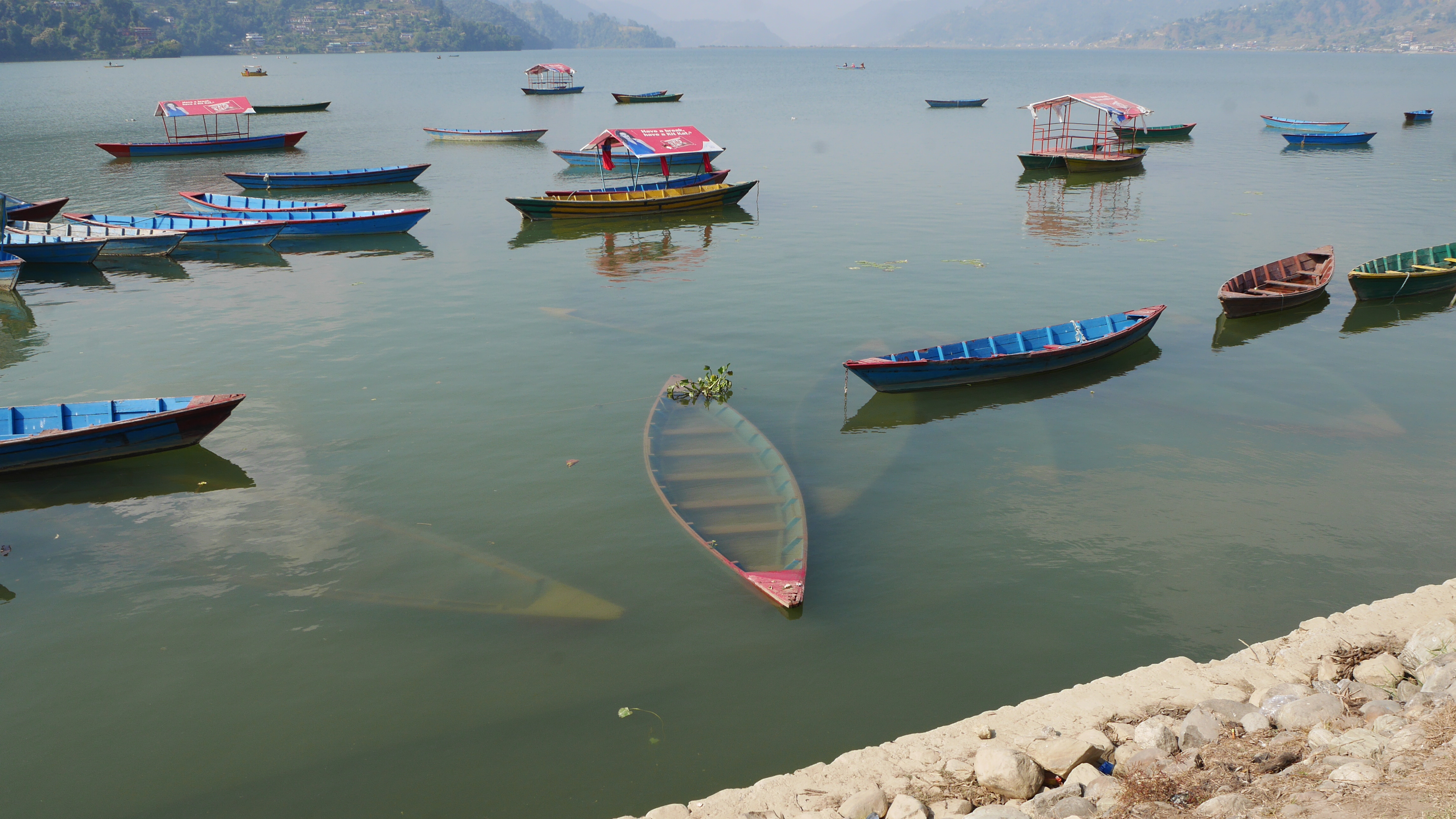
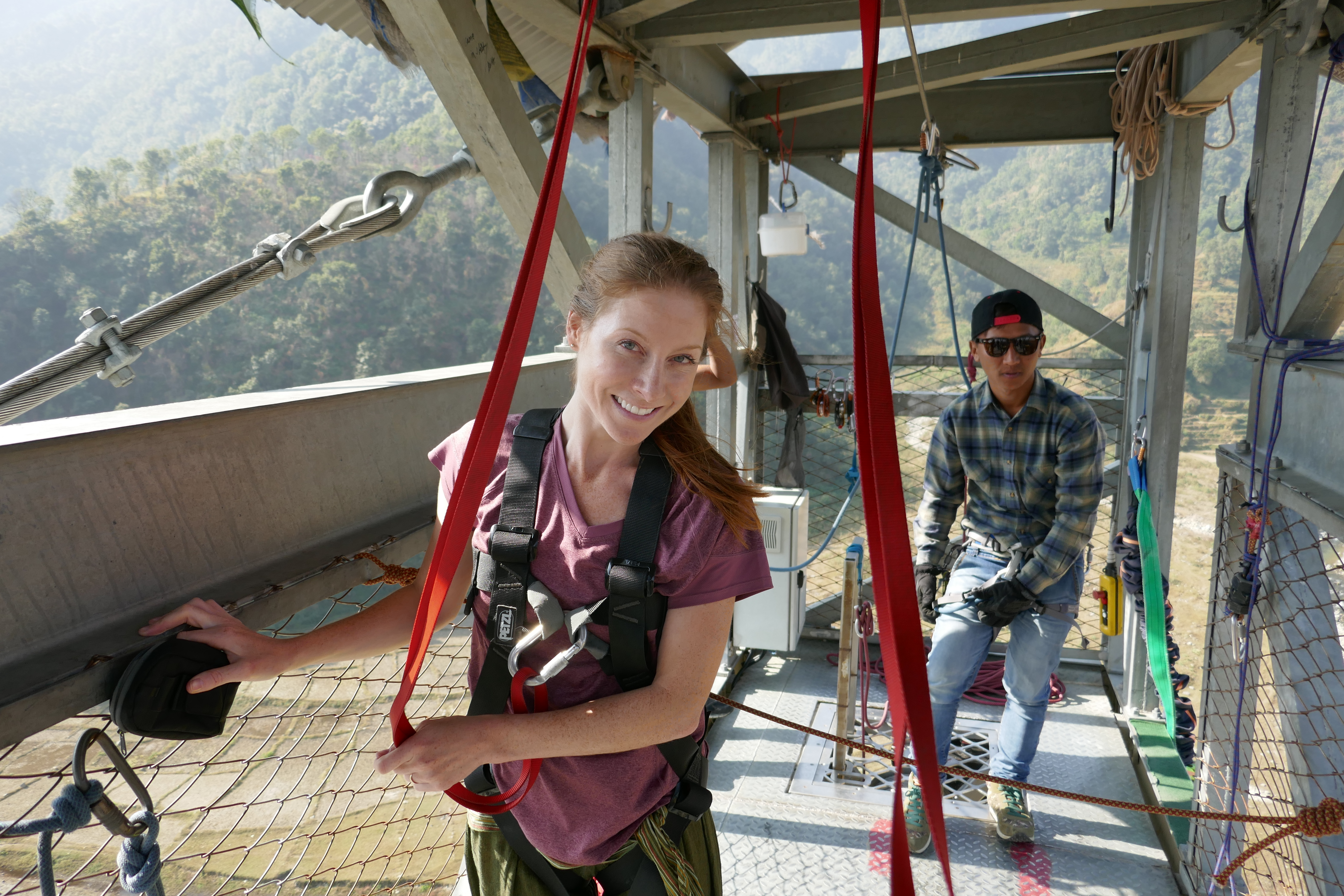
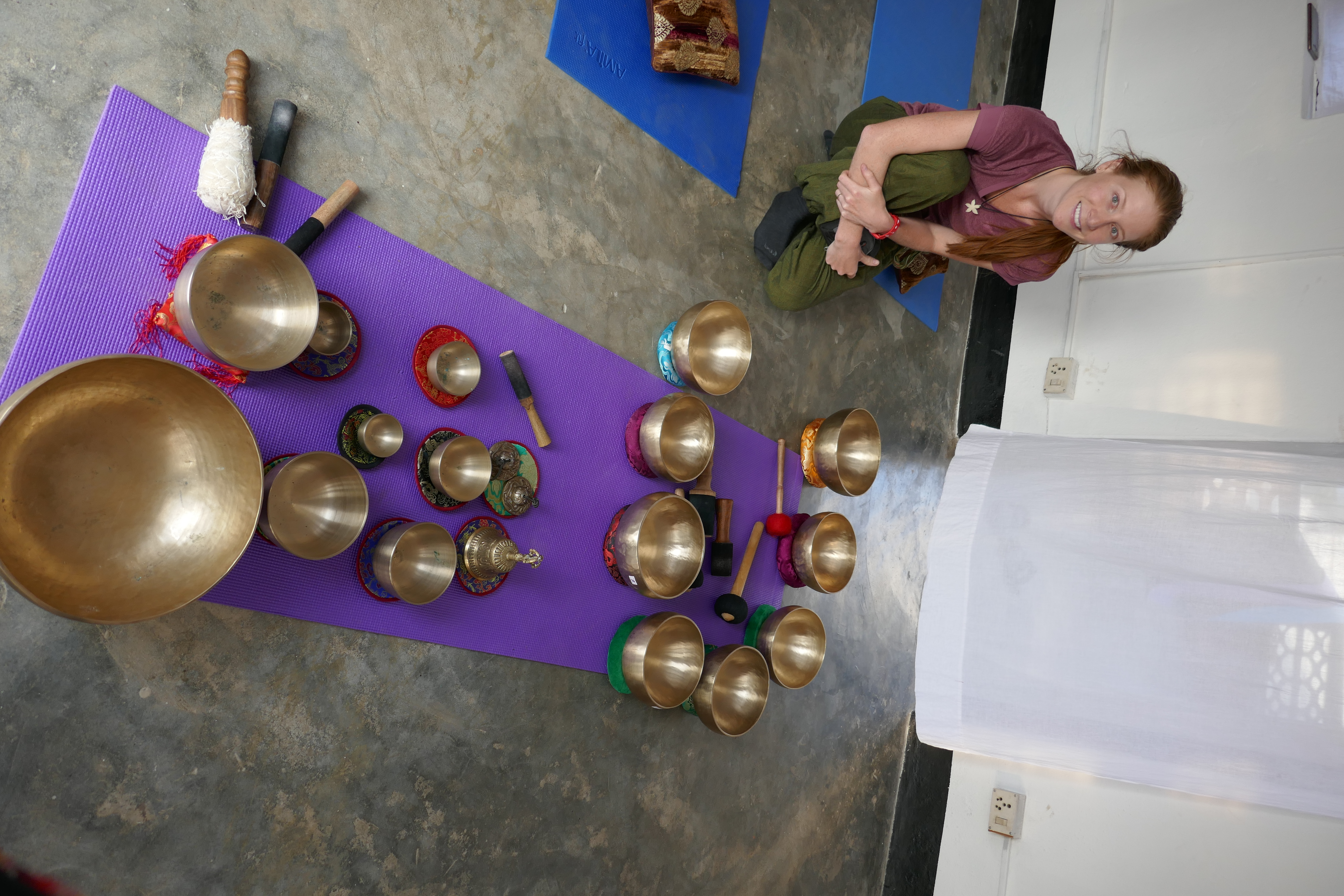
Chitwan National Park
With half our extra smelly clothes triple bagged we continued our journey to Chitwan national park. Going on safari was risky for us. Our expectations after Africa were unbeatable from a few years before. Even today we wait for the same company to take us to the Congo. The black rhinos in Africa were elusive animals, scared off by the rangers from the roads due to fear of poaching. While we saw over 10, binoculars were a must. Nepal was completely different. Off roading was also not permitted, however who needs a road when you ride an elephant through the jungle. The elephants took us over terrain unreachable by jeep right up to the rhinos so we could almost touch them. We also figured out that the elephants ruled the jungle, approaching in numbers, the rhinos would retreat backwards soon after standing their ground. My love for elephants grew in the three days I spent with them. Our hotel even had their own elephants that tooted randomly during the night. Touching these enormous graceful animals was strange and the tip of their trunk almost resembled a finger. The trunk alone has 40,000 muscles in it, some of which I had the pleasure of experiencing during a private elephant shower. It was strange seeing the elephants in captivity. It was sad, but they were well taken care of and couldn’t help making you smile. Their intelligence was astounding and they obeyed commands with what looked like a continuous smile. Safari was a relaxing way to end our trip. I still can’t believe that we almost stood face to face with a rhino and floated down a river in a shabby wooden canoe, with crocodiles sunbaking on the banks. The crocodiles were definitely bigger than us. Chitwan national park was just another pocket of Nepal, a country that lures even the Swiss from their beautiful mountains.
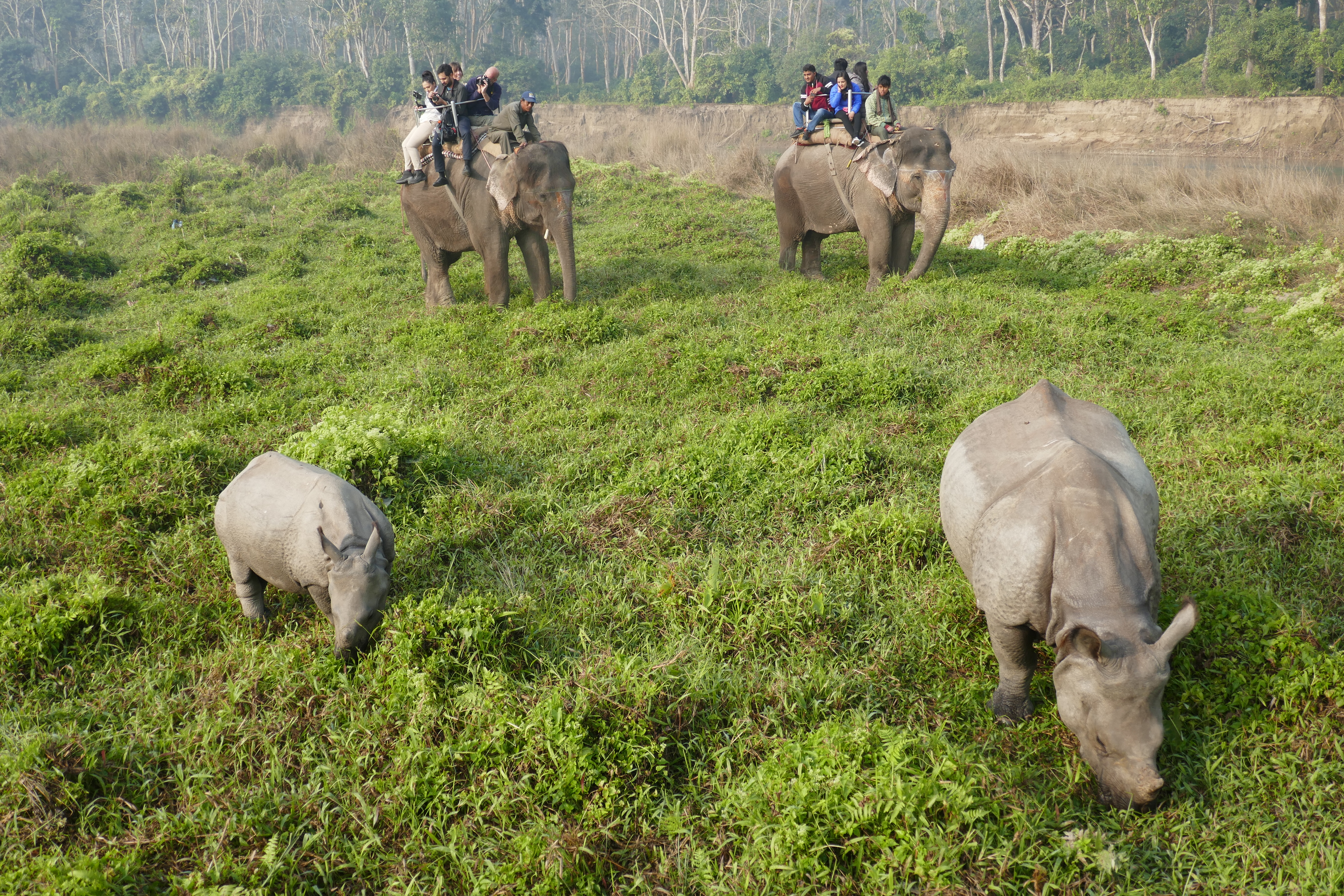
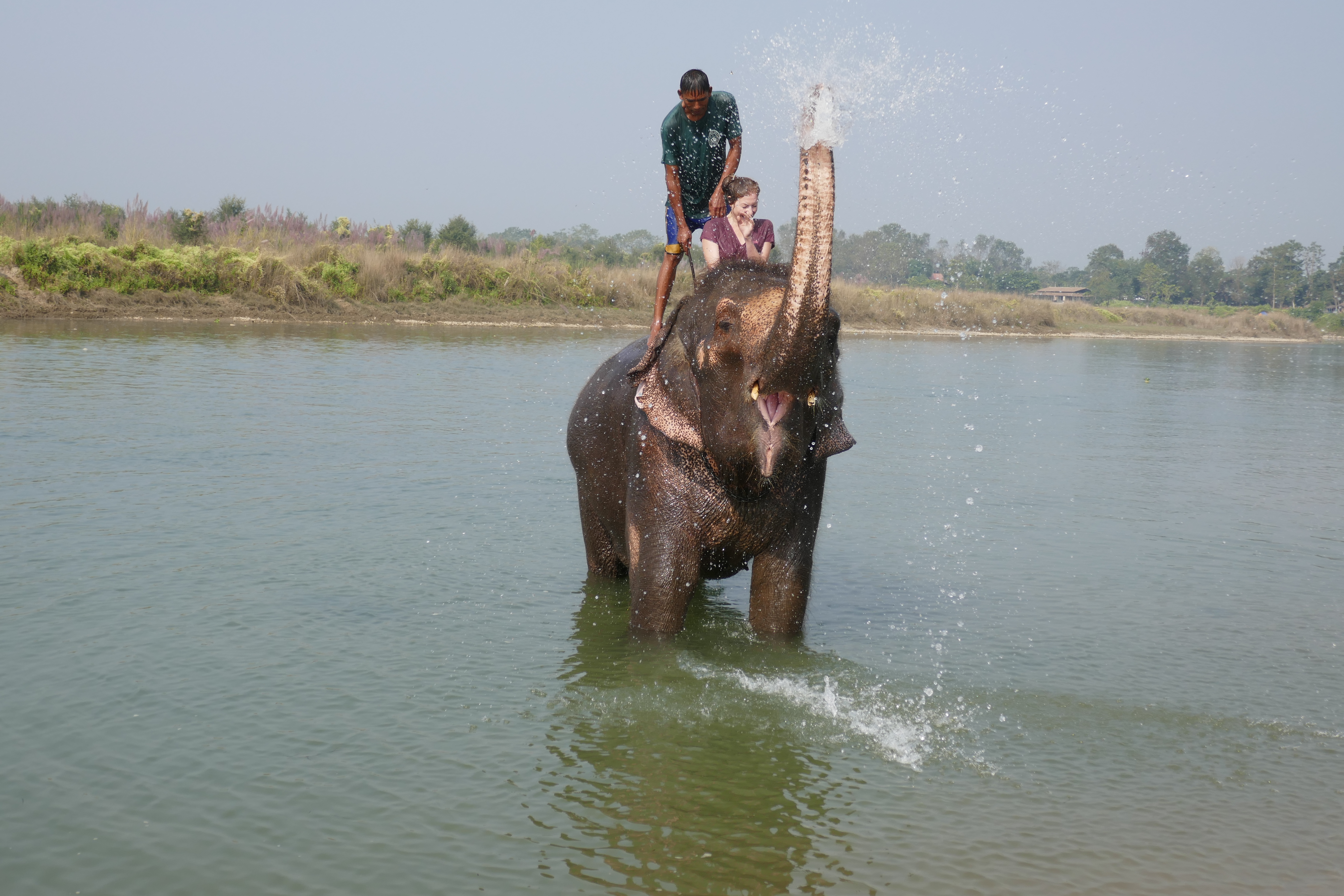
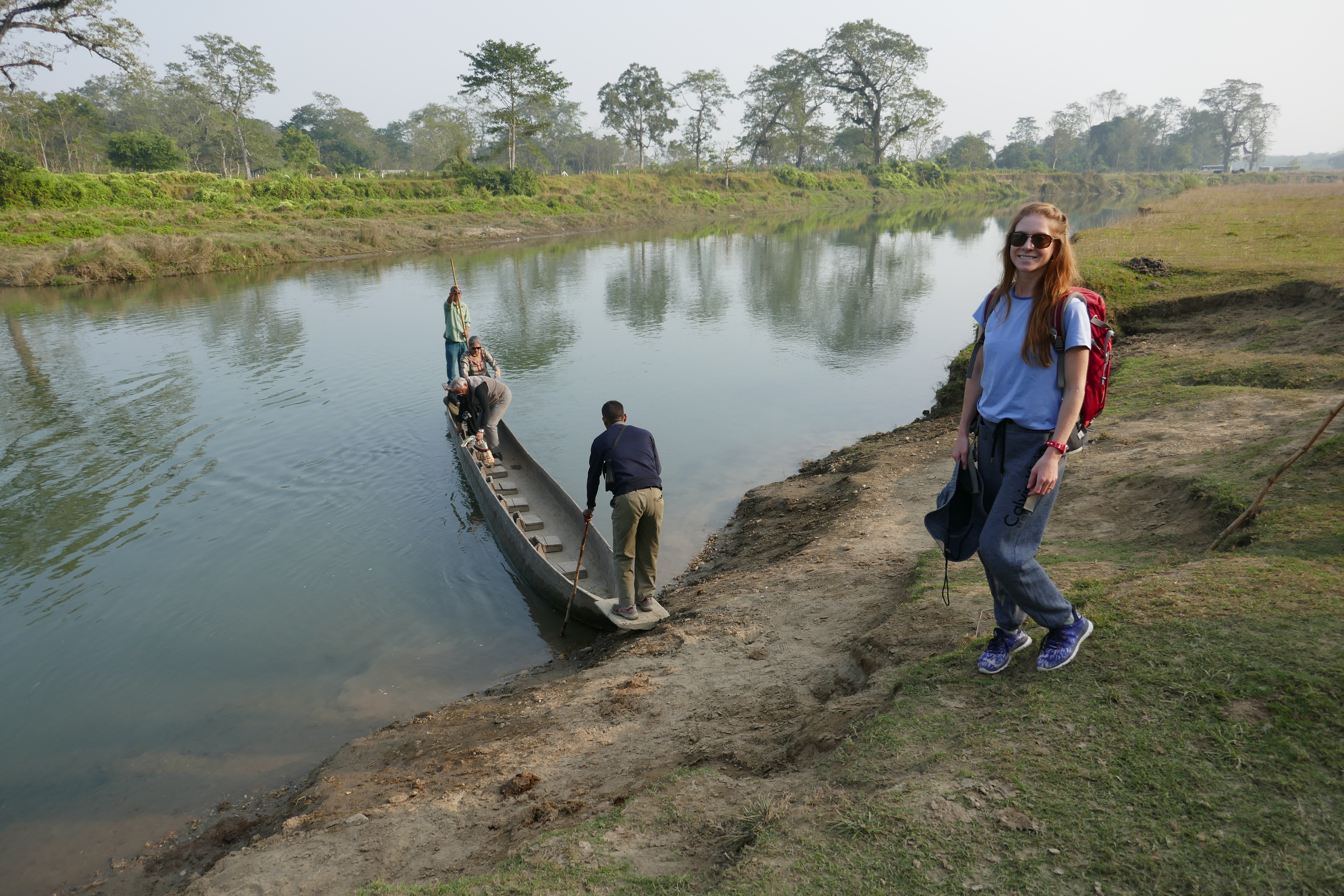
A few other interesting things I learned and want to share:
My misinterpretation of the word ‘Sherpa’
Sherpa is the name of an ethnic group and is synonymous with the Himalayas to people everywhere. The Sherpa population are the backbone of mountain tourism and also the entire tourism industry of Nepal. They work extremely hard and treat their clients almost like deities, doing all they can, including losing their own lives to allow their clients to reach the summit. Today the word Sherpa is often misused. Remember ‘Sherpa’ is not the name of an occupation or clothing brand.
Why we strung prayer flags along mountain ridges in peaks in the Himalayas
Prayer flags come in a set of five, each with five colors in order from left to right- blue, white, red, green and yellow. The colors represent the five elements- sky, air, fire, water and earth as five pure lights. The prayers and mantras printed on the flags are blown out into the world spreading goodwill and compassion to everyone.
A special thanks to our manager, guides and porters at Imperial Nepal Treks.
You made our personalized trek one to remember and caused us to become addicted to Nepal’s mountains. Our bug for mountain climbing just got even more embedded into our dreams and passion.
K.C. Himraj: Main Guide
Bhuwan: Assistant Guide
Raju (Raschu): Porter
Binayek: Porter
Prakash: Porter
Company: www.imerialnepaltreks.com
To check out a video of our picturesque vacation please click on the following link created by my sister Ela Saner.
https://youtu.be/kbT-x_TJ4Dw
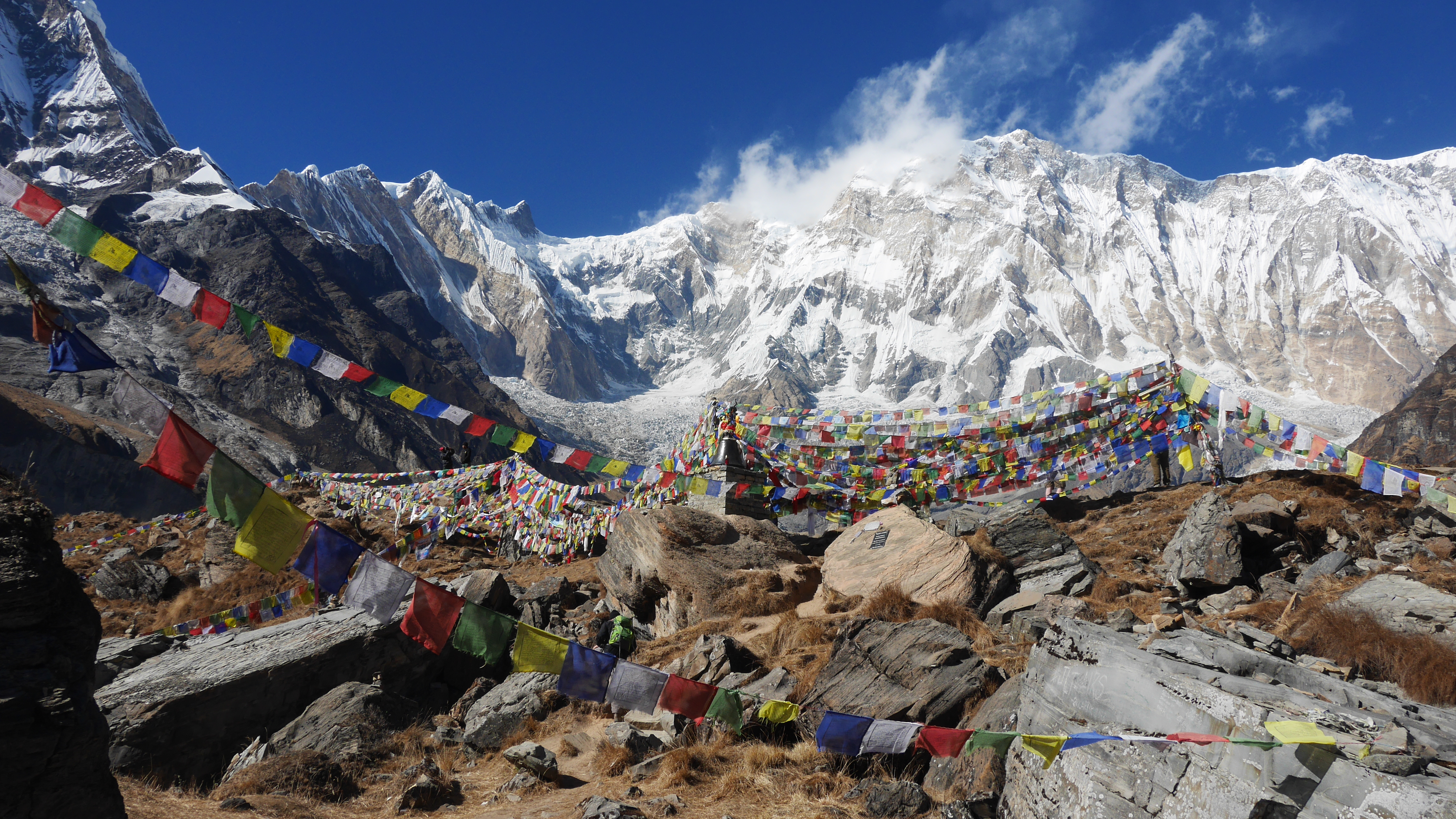
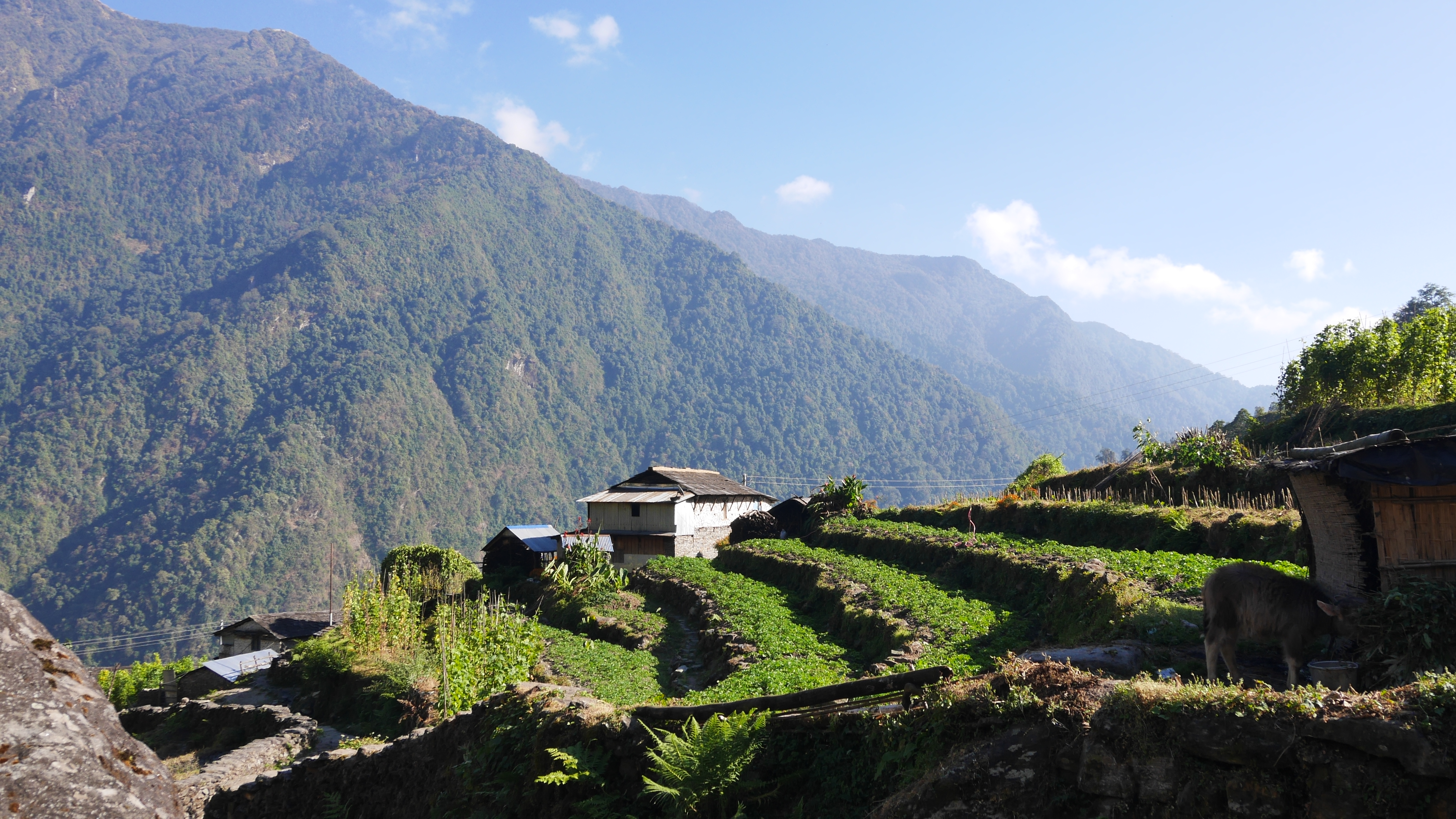


3ml9mv